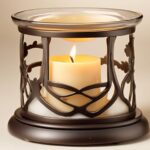Candles
What Is a Candle Warmer Used for

Have you ever wondered what the purpose of a candle warmer is?
Well, we coincidentally have the answer for you!
Candle warmers are a fantastic way to enjoy the soothing ambiance and delightful fragrance of a candle without having to light it.
With a candle warmer, we can effortlessly enhance the scent of our favorite candles and create a cozy atmosphere in any room.
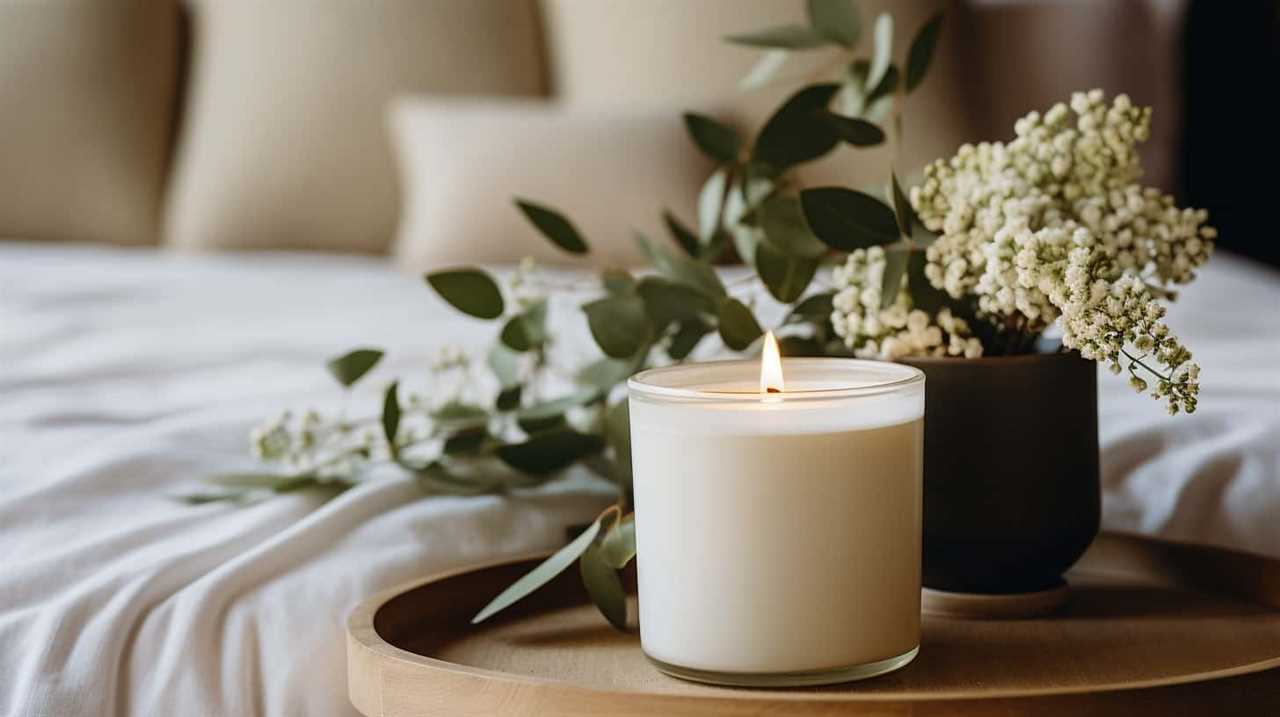
Not only that, but using a candle warmer also eliminates the risk of fire hazards associated with an open flame.
Plus, it helps extend the life of our candles, allowing us to enjoy them for longer periods.
So, whether you’re looking for aromatherapy, stress relief, home fragrance, or a thoughtful gift, a candle warmer is the perfect solution!
Key Takeaways
- Enjoy the ambiance and fragrance of a candle without lighting it.
- Enhance the scent of candles more quickly and evenly.
- Create a cozy atmosphere in any room.
- Eliminate the risk of fire hazards associated with an open flame.
Benefits of Using a Candle Warmer
Using a candle warmer offers us numerous benefits, making it a practical and convenient choice for enjoying the fragrance and ambiance of candles.
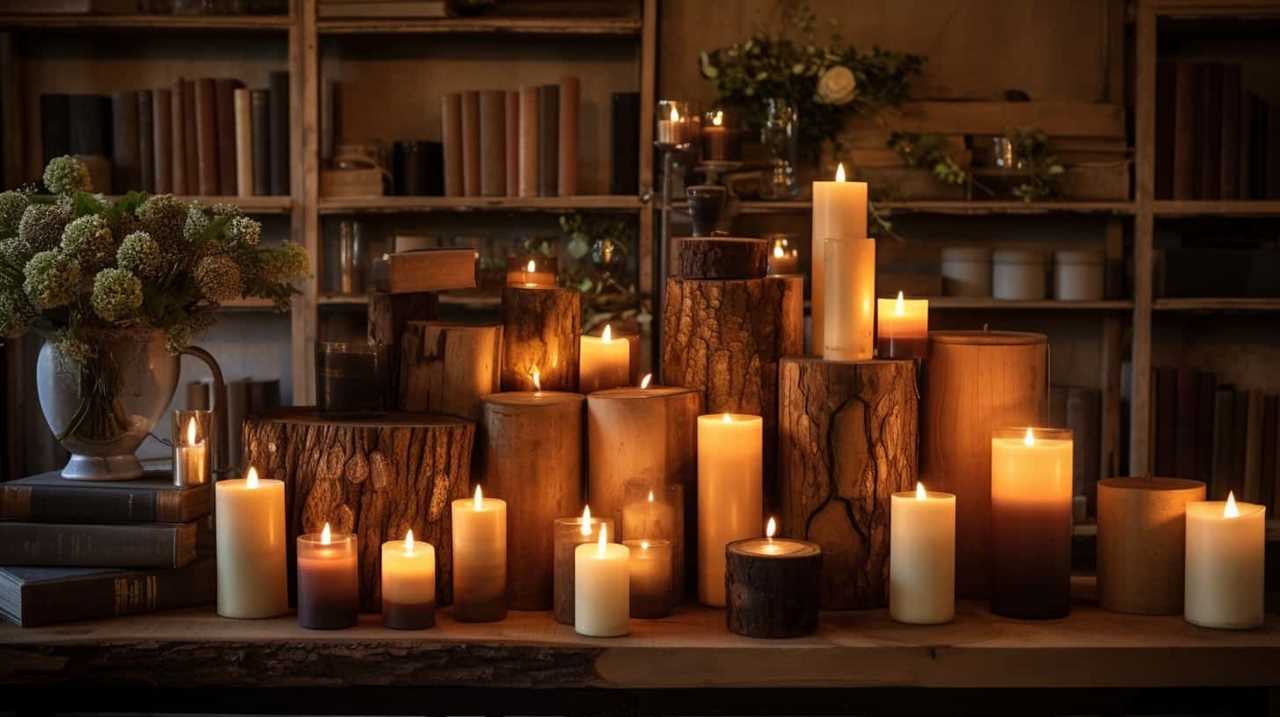
One of the primary advantages of using a candle warmer is the ability to enhance the fragrance of the candle. When the candle is warmed, the scent is released more quickly and evenly, filling the room with a delightful aroma.
Additionally, candle warmers can be used for decorative purposes. With a wide variety of designs and styles available, they can add a touch of elegance and beauty to any room.
Whether you want to create a cozy atmosphere or simply enjoy the soothing glow of a candle, a candle warmer provides a safe and efficient way to do so.
Now, let’s explore how a candle warmer actually works to achieve these benefits.
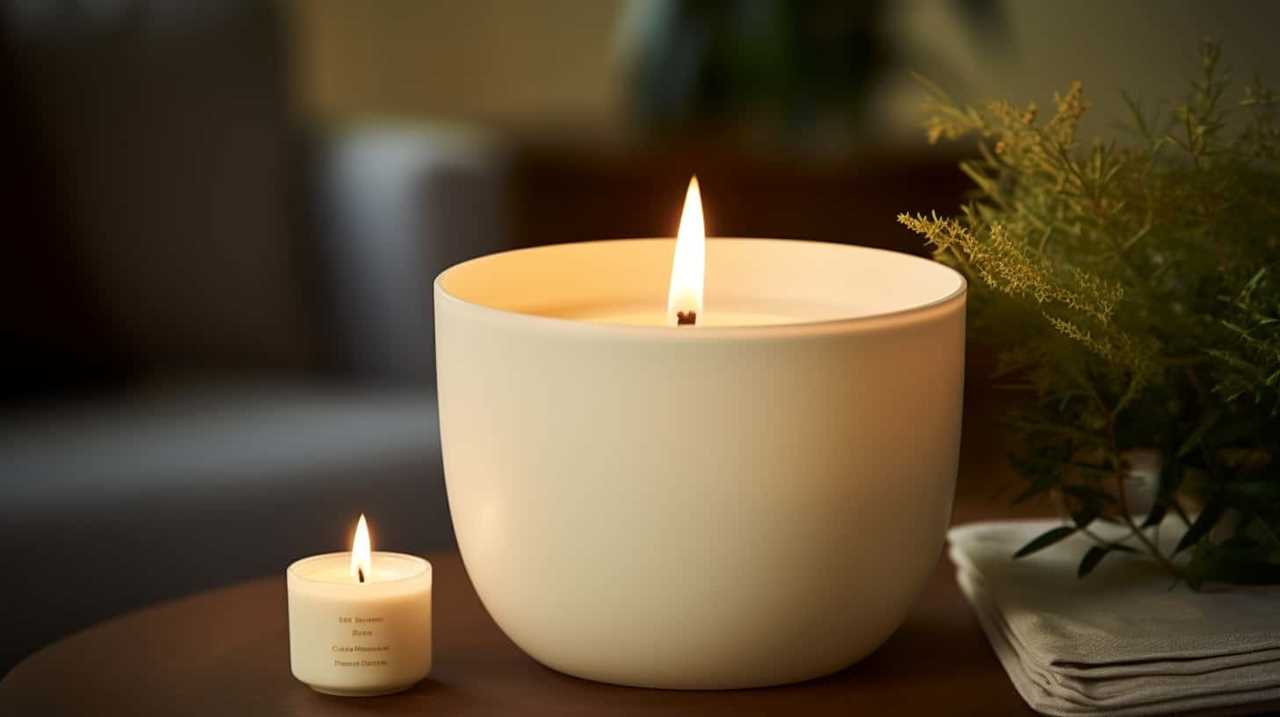
How Does a Candle Warmer Work
To understand how a candle warmer works, let’s delve into the mechanics behind its functionality. Candle warmers are designed to melt the wax in a candle without the need for an open flame.
Here’s how they work:
- The candle warmer consists of a heating element, usually a hot plate or light bulb, which generates heat.
- The heat is transferred to the base of the candle, causing the wax to melt slowly.
- As the wax melts, the fragrance is released into the air, filling your space with a pleasant aroma.
- Candle warmers are a safe alternative to traditional candles as they eliminate the risk of fire hazards.
Using candle warmers for home decor allows you to enjoy the ambiance and fragrance of candles without the worry of an open flame. They also provide a cost-effective alternative to constantly replacing candles.
Enhancing the Scent of Your Candle
To enhance the scent of our candle, we can add a few drops of essential oil directly onto the melted wax. This simple trick can transform the atmosphere in any room and create a more relaxing and inviting ambiance. The essential oil will mix with the melted wax and release its fragrance as the candle warms up.

For those who want to get creative, there are also candle warmer alternatives available. One popular option is to make a DIY candle warmer using a heat-resistant dish or a small glass jar placed on top of a coffee warmer or a mug warmer. This allows for a controlled heat source that gently warms the wax and releases the scent without the need for an open flame.
Avoiding Fire Hazards With a Candle Warmer
To ensure the safety of our home, we take precautions when using a candle warmer. Avoiding fire hazards is of utmost importance, and implementing safety precautions is essential. Here are some key steps we follow to minimize the risk:
- Always place the candle warmer on a flat, heat-resistant surface.
- Keep the candle warmer away from flammable materials like curtains, papers, or furniture.
- Never leave the candle warmer unattended, especially when there are children or pets around.
- Regularly check the power cord for any signs of damage or fraying.
By adhering to these safety precautions, we can enjoy the cozy ambiance of a candle warmer without worrying about potential fire hazards.
Longevity of Your Candle With a Candle Warmer
Using a candle warmer can significantly extend the burn time of your candle, allowing you to enjoy its cozy ambiance for longer periods.

By gently heating the wax without an open flame, the candle melts evenly and slowly, maximizing its lifespan.
Additionally, a candle warmer helps preserve the fragrance of the candle, as the gradual warming process releases the scent more gradually and evenly, preventing it from dissipating too quickly.
Extended Candle Burn Time
By using a candle warmer, we can extend the burn time of our candles, ensuring their longevity. This not only allows us to enjoy our favorite scents for longer, but also maximizes the value of our candle purchases.
Here are four reasons why using a candle warmer can help in achieving extended burn time:

- The heat from the warmer gently and evenly melts the wax, allowing it to last longer compared to burning a candle with a flame.
- Since there’s no open flame, the wax doesn’t evaporate as quickly, resulting in a slower burn rate.
- By using a candle warmer, the fragrance oils in the wax are released more gradually, creating a consistent and long-lasting aroma throughout the room.
- Candle warmers typically have an adjustable temperature setting, allowing us to control the rate at which the wax melts and prolonging the life of the candle.
With a candle warmer, we can enjoy the extended burn time of our candles, indulging in their delightful scents for hours on end.
Preserving Candle Fragrance
With a candle warmer, we can enhance the longevity of our candle’s fragrance and enjoy its delightful scent for an extended period of time. The heat from the candle warmer gently warms the wax, releasing the fragrance into the air without burning the candle. This method of scent diffusion helps in preserving the scent of the candle, as the fragrance isn’t quickly consumed by the flame.
By using a candle warmer, we can prolong the fragrance of our candles, allowing us to savor their enticing aroma for longer durations. Whether it’s a relaxing lavender scent or a cozy vanilla fragrance, a candle warmer ensures that the scent lingers in our space, creating a soothing and inviting atmosphere.
Now, let’s explore how candle warmers can be used for decorative purposes.
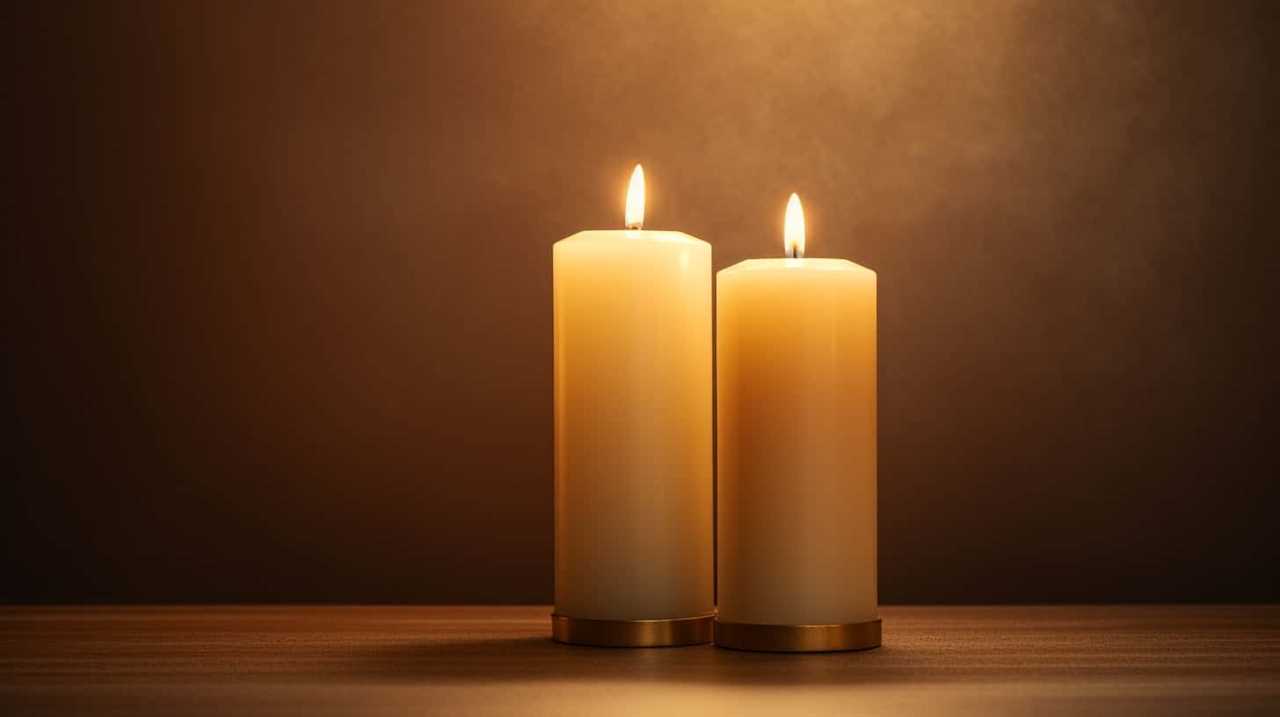
Using Candle Warmers for Decorative Purposes
For enhancing our home decor, candle warmers serve as a stylish and practical solution. Not only do they provide a safe alternative to traditional candles, but they also add a touch of elegance to any room.
Here are some decorative uses of candle warmers:
- Creating a cozy ambiance: The soft glow emitted by the candle warmer creates a warm and inviting atmosphere.
- Adding a decorative element: Candle warmers come in various designs and styles, allowing you to choose one that matches your home decor.
- Showcasing your favorite scents: With a candle warmer, you can display your favorite scented candles without worrying about open flames.
- Serving as a centerpiece: Placing a candle warmer in the center of your dining table or coffee table can instantly elevate the look of the space.
With their versatility and beauty, candle warmers are a must-have for anyone looking to enhance their home decor.
Now, let’s explore the different types of candle warmers available on the market.

Different Types of Candle Warmers
Now let’s talk about the different types of candle warmers available and the benefits they offer.
Candle warmers can be categorized into two main types: wax warmers and oil warmers. Wax warmers use a heat source to melt and release the fragrance of a scented candle, while oil warmers use a small dish to hold scented oils that are heated to produce a pleasant aroma.
When choosing a candle warmer, it’s important to consider factors such as personal preference, safety features, and the type of fragrance you want to enjoy.
Benefits of Candle Warmers
As candle warmers come in various types, we can enjoy the benefits they offer. Using a candle warmer not only adds a touch of elegance to our living spaces, but it also serves as a safe alternative to open flame candles. Here are some of the benefits of using a candle warmer:
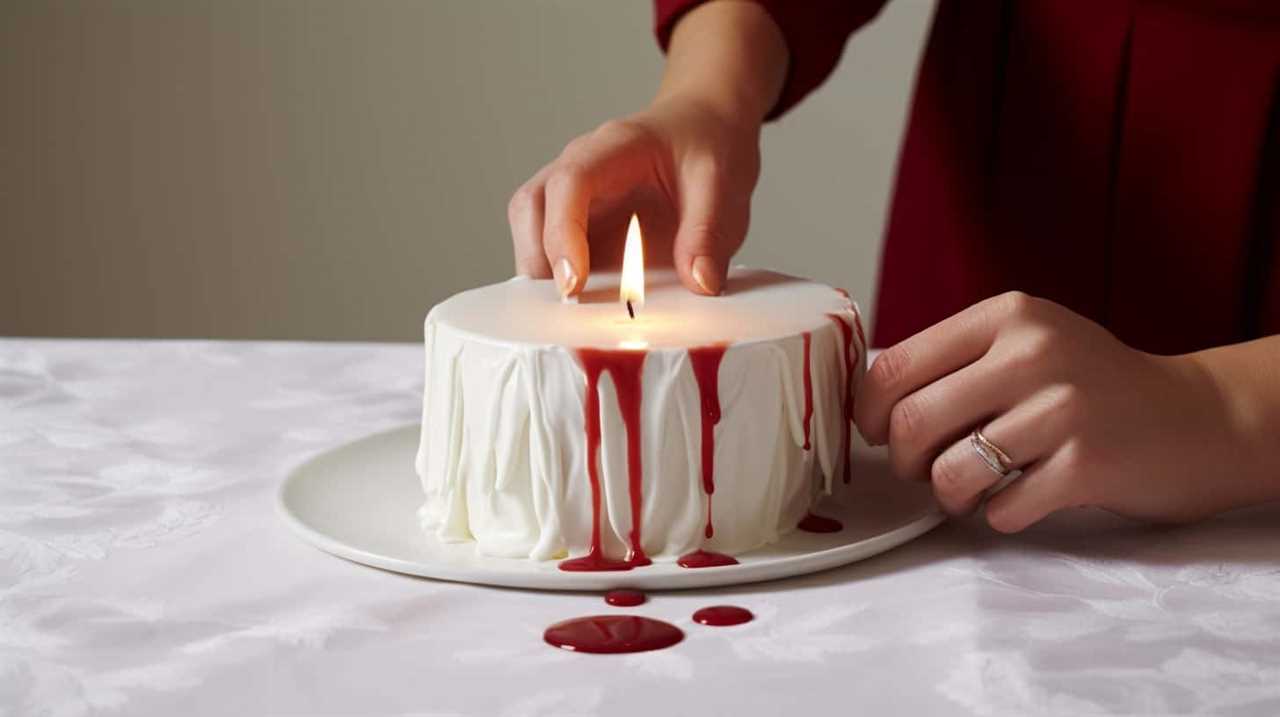
- Longer lasting fragrance: Unlike traditional candles that burn through the wax, candle warmers gently heat the wax, allowing the fragrance to last longer.
- Decorative purposes: Candle warmers come in a wide range of designs and styles, making them a perfect addition to any home decor. They can be used as decorative pieces even when not in use.
- No soot or smoke: By eliminating the need for a flame, candle warmers prevent the release of soot or smoke, ensuring a clean and healthy environment.
- Cost-effective: Since candle warmers only require electricity to function, they’re more cost-effective than constantly purchasing new candles.
With these benefits in mind, let’s now explore the differences between wax and oil warmers.
Wax Vs Oil Warmers
Moving on from the benefits of candle warmers, let’s now delve into the different types of candle warmers – wax vs oil warmers.
When it comes to wax warmers, they’re specifically designed to melt wax and release its fragrance into the air. The wax is placed in a dish or tray and heated by a warming plate or bulb, allowing it to melt slowly and fill the room with a pleasant scent. Wax warmers offer a wide variety of fragrance options, allowing you to choose from a range of scents to suit your preference.
On the other hand, oil warmers use a small dish or tray to hold scented oils, which are heated by a candle or electric heating element. The heat from the candle or element causes the oil to evaporate, releasing its fragrance into the air. Oil warmers also offer a diverse range of fragrance options, making it easy to find the perfect scent for your space.

Choosing the Right Warmer
To begin our discussion on choosing the right warmer for your needs, let’s explore the different types of candle warmers available. Here are some options to consider:
- Plate Warmers: These warmers use a heating element to melt the candle from underneath. They’re simple and affordable, but may not distribute heat evenly.
- Lamp Warmers: These warmers have a bulb inside that heats the candle from above. They provide a gentle and consistent heat, perfect for long-lasting fragrance.
- Plug-in Warmers: These compact warmers plug directly into the wall socket and are ideal for small spaces. They’re convenient and easy to use.
- Lantern Warmers: These decorative warmers combine the functionality of a warmer with the allure of a lantern. They add a touch of elegance to any space.
When choosing the right style, consider your preferences and the size of the room. Additionally, remember to follow maintenance and cleaning tips to ensure the longevity of your candle warmer.
Now, let’s move on to the next section about candle warmers for aromatherapy.
Candle Warmers for Aromatherapy
Using a candle warmer for aromatherapy enhances our well-being by gently diffusing the soothing scents of essential oils. Not only can candle warmers create a cozy atmosphere, but they also provide an effective way to enjoy the benefits of aromatherapy. By heating the essential oils, the candle warmer releases their therapeutic properties into the air, allowing us to breathe in the calming fragrances. To highlight the versatility of candle warmers, here are some alternative uses for them:

| Uses | Benefits |
|---|---|
| Wax melts | Safe and flameless option |
| Scented oils | Customizable fragrances |
| Essential oil blends | Enhanced relaxation |
| Aromatherapy candles | Long-lasting scents |
| Home fragrance oils | Freshen up any space |
With proper candle warmer maintenance, such as regularly cleaning the dish and changing the wax or oil, we can ensure a consistent and enjoyable aromatherapy experience. Now, let’s explore how candle warmers can help alleviate stress and promote relaxation.
Candle Warmers for Stress Relief
Candle warmers can provide us with stress relief by creating a soothing atmosphere and releasing calming fragrances. Here are four ways candle warmers can help alleviate stress:
- Soothing ambiance: The soft glow of a candle warmer creates a cozy and tranquil environment, helping to calm our minds and reduce stress levels.
- Aromatherapy benefits: Candle warmers release fragrances that can have a therapeutic effect on our mood. Scents like lavender, chamomile, and vanilla are known to promote relaxation and relieve stress.
- Safe and hassle-free: Unlike traditional candles, candle warmers eliminate the risk of fire hazards and messy wax spills, allowing us to unwind without any worries.
- Versatile stress relief: Whether we’re enjoying a warm bath, practicing yoga, or simply reading a book, candle warmers can enhance our stress-relief activities, making them even more enjoyable and effective.
Candle Warmers for Home Fragrance
When it comes to home fragrance, candle warmers play a crucial role in creating a pleasant and inviting atmosphere.
The wax melting process of candle warmers ensures a slow and steady release of fragrance, allowing the scent to fill the room gradually without overwhelming the senses.
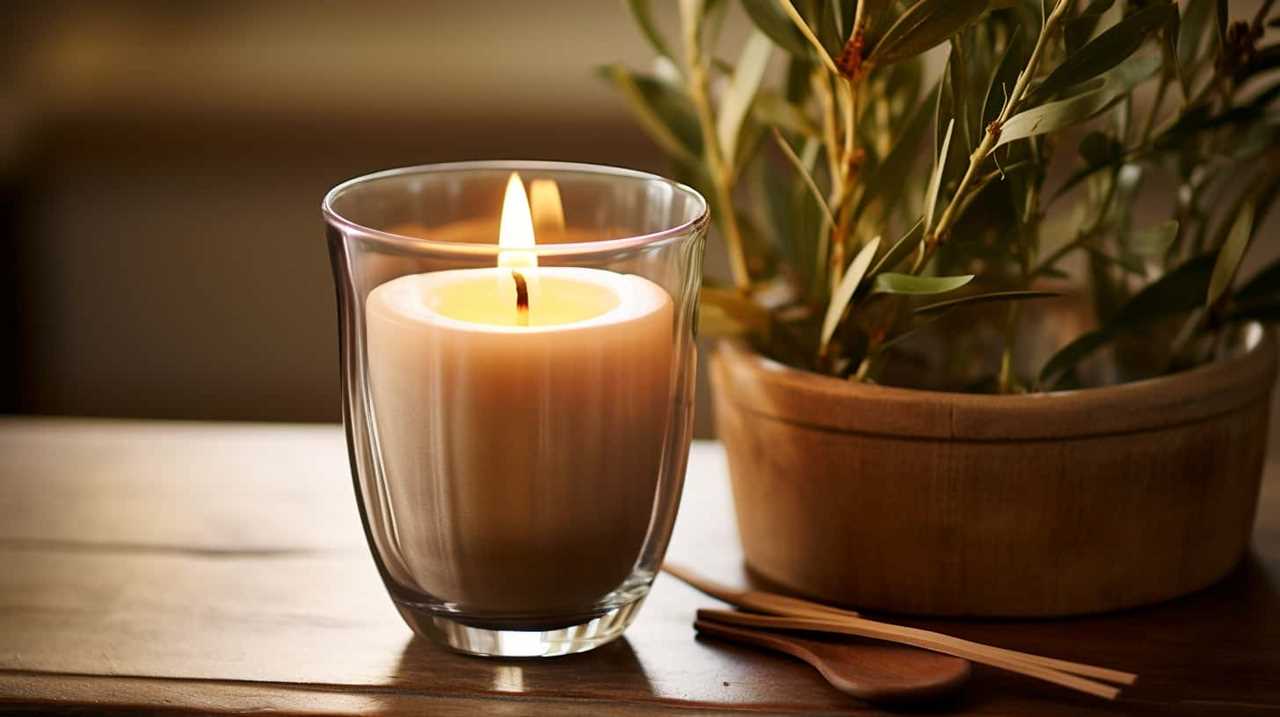
This enhanced fragrance release not only provides a soothing and comforting ambiance but also helps to eliminate unwanted odors.
Candle warmers are a safe and convenient option for achieving a delightful home fragrance experience.
Wax Melting Process
During our home fragrance sessions, we love how candle warmers effortlessly melt wax, creating a cozy ambiance and releasing delightful scents into our living space. The wax melting process is simple yet effective, allowing us to enjoy our favorite fragrances without the hassle of lighting a candle.
Here are the benefits of using a candle melting dish:
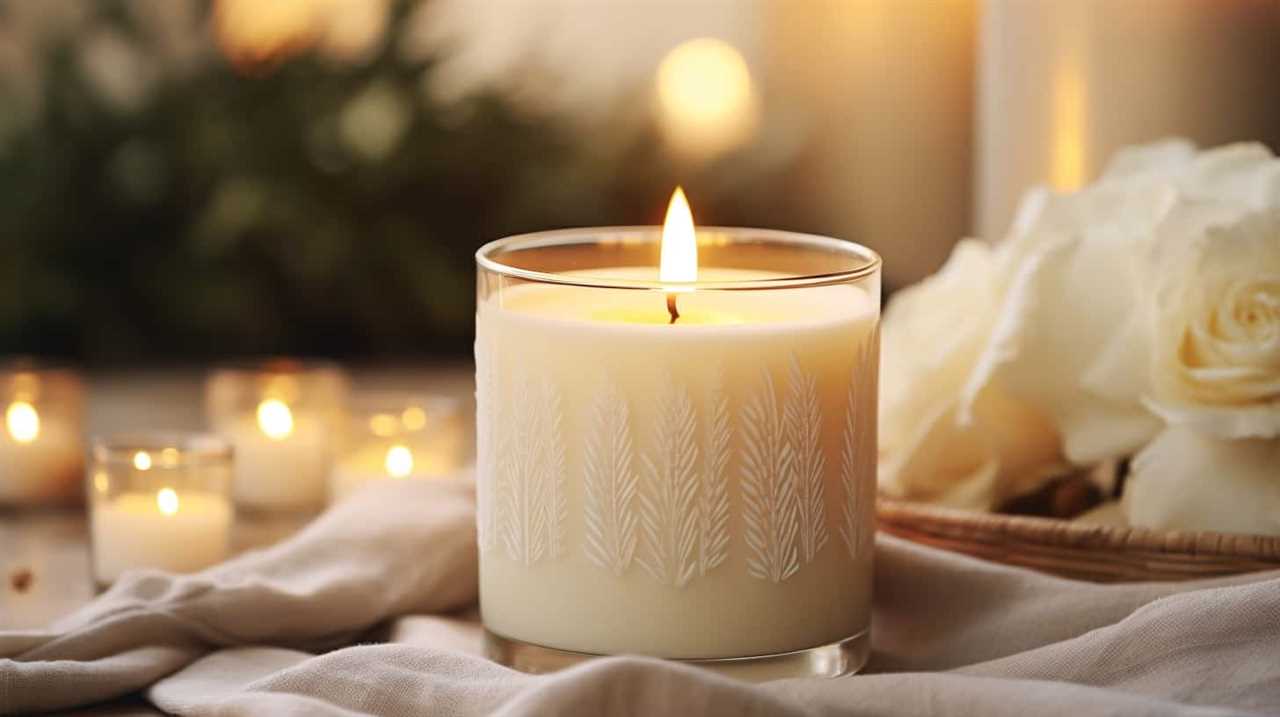
- Convenience: With a candle warmer, there’s no need to worry about open flames or constantly monitoring a burning candle.
- Even Heat Distribution: The warmers use gentle heat to evenly melt the wax, ensuring a consistent fragrance release.
- Longer Lasting Fragrance: By melting the wax slowly, the scent is released gradually, making it last longer compared to burning a candle.
- Easy Cleanup: When the wax has melted, it can be easily removed from the dish, leaving no residue behind.
Using a candle warmer not only enhances our home with beautiful scents but also provides a safer and more convenient way to enjoy our favorite fragrances.
Enhanced Fragrance Release
We love how candle warmers enhance the fragrance release in our home, creating an even more inviting atmosphere. By gently heating the wax, candle warmers allow the scent to disperse throughout the room without the need for an open flame. This method not only ensures a consistent and long-lasting fragrance, but it also eliminates the need to constantly monitor the burning candle.
The wax melting process is controlled and safe, providing a convenient alternative to traditional candles. With a candle warmer, you can enjoy your favorite scents without worrying about fire hazards or the hassle of trimming wicks. It’s a simple yet effective way to fill your home with delightful aromas.
Speaking of safety and convenience, let’s now explore how candle warmers offer these benefits in more detail.
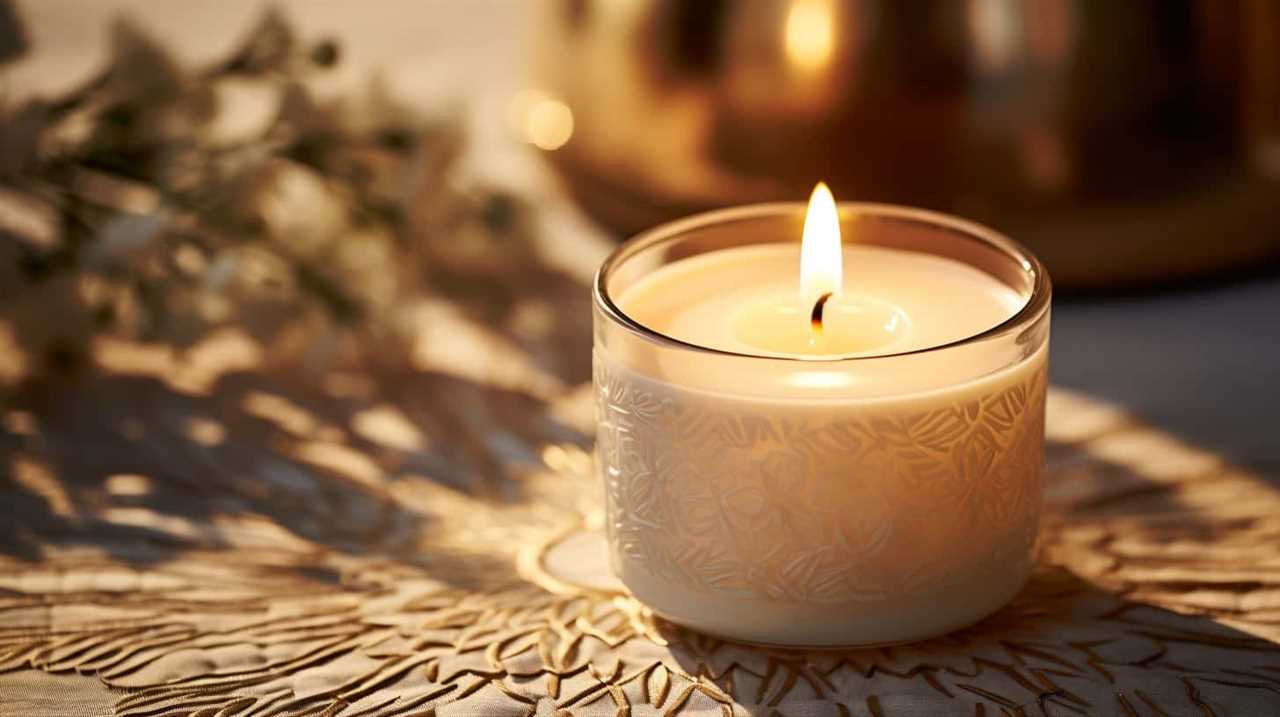
Safety and Convenience
Candle warmers provide a safe and convenient way for us to enjoy home fragrance. With proper candle warmer maintenance, they can be a reliable addition to our living spaces.
Here are some reasons why candle warmers are both safe and convenient:
- No open flame: Unlike traditional candles, candle warmers eliminate the risk of fire hazards. They use a warming plate or bulb to gently heat the wax, releasing fragrance without an open flame.
- Long-lasting fragrance: Candle warmers can provide hours of continuous fragrance without the need to constantly monitor or replace a burning candle.
- Easy to use: Simply place a wax melt or jar candle on the warmer, switch it on, and enjoy the scent. No need to worry about trimming wicks or dealing with melted wax.
- Choosing the right size: Candle warmers come in various sizes to accommodate different candle types. It’s essential to choose the right size to ensure proper heat distribution and fragrance release.
Candle Warmers for Gift Giving
For gift giving, candle warmers are an ideal choice to create a cozy and inviting atmosphere. Not only do they serve as a practical home decor item, but they also provide a sense of relaxation and tranquility. Whether it’s for a housewarming, birthday, or holiday present, candle warmers make a thoughtful and unique gift that will be appreciated by anyone. To help you find the perfect candle warmer for your loved ones, here is a table showcasing different types and their features:
| Type of Candle Warmer | Features |
|---|---|
| Electric | Safe and convenient to use, adjustable temperature settings |
| Ceramic | Stylish and decorative, comes in various designs and colors |
| Lantern | Provides a warm and flickering light, creates a cozy ambiance |
With a candle warmer, you can give the gift of both beautiful home decor and a peaceful atmosphere, making it a present that will be cherished for years to come.

Frequently Asked Questions
Can I Use a Candle Warmer With Any Type of Candle?
Yes, you can use a candle warmer with any type of candle. It’s a convenient way to enjoy the benefits of a candle without worrying about an open flame.
How Long Does It Take for a Candle to Fully Melt on a Candle Warmer?
On a candle warmer, the melting time of a candle depends on its size and composition. The temperature control feature allows us to adjust the heat to ensure a slow, even melt, preserving the fragrance and extending the candle’s lifespan.
Can I Leave a Candle Warmer Unattended?
Leaving candle warmers unattended can pose potential dangers. It is important to always monitor them to prevent accidents. Unattended warmers may lead to fire hazards or other safety risks, so it’s crucial to prioritize safety and never leave them alone.
Are There Any Safety Precautions I Need to Take When Using a Candle Warmer?
When it comes to candle warmer safety, it is crucial to use proper candle warmers. We cannot stress enough the importance of following safety precautions to ensure a worry-free and enjoyable experience.

Can I Use a Candle Warmer With Scented Wax Melts or Essential Oils Instead of a Candle?
Yes, you can use a candle warmer with scented wax melts or essential oils instead of a candle. It’s a great way to fill your space with delightful aromas without the worry of an open flame.
Conclusion
In conclusion, a candle warmer is a versatile and convenient tool that enhances the benefits of using a candle. It not only eliminates the need for an open flame, reducing fire hazards, but also prolongs the life of your candle.
With a candle warmer, you can create a soothing ambiance, enhance the scent of your candle, and even use it for aromatherapy or stress relief. It’s a perfect addition to your home fragrance collection or a thoughtful gift for loved ones.
Like a gentle breeze carrying enchanting aromas, a candle warmer adds an extra touch of magic to your space.
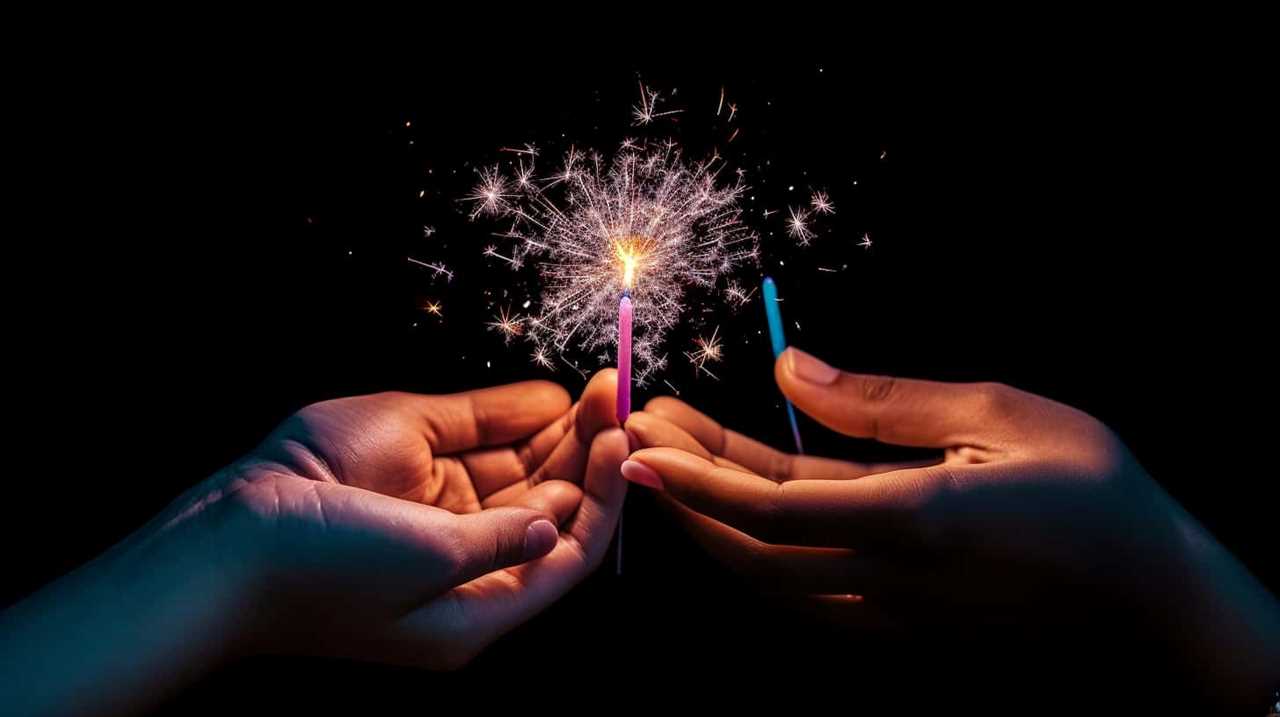
I’m Jane and I love candles. I have candles everywhere in my house–in every room, on every surface. I love the smell of candles, and I love how they make my place feel warm and cozy.
Candles are really important to me. They help me relax and de-stress after a long day. They remind me of happy memories, and they make me feel calm and peaceful. I can’t imagine my life without candles!
Candles
What Is a Tealight Candle

Hello! Have you ever wondered about the true nature of a tealight candle? Let me shed some light on that for you!
Tealight candles are these little wonders that bring warmth and coziness to any space. They’re like the tiny knights of ambiance, ready to serve your needs.
Made from a mixture of paraffin wax and other natural materials, these small but mighty candles are designed to burn for hours, spreading a soft and gentle glow.
Whether you’re hosting a romantic dinner, creating a soothing atmosphere for a bubble bath, or simply adding a touch of magic to your decor, tealight candles are the perfect companions.
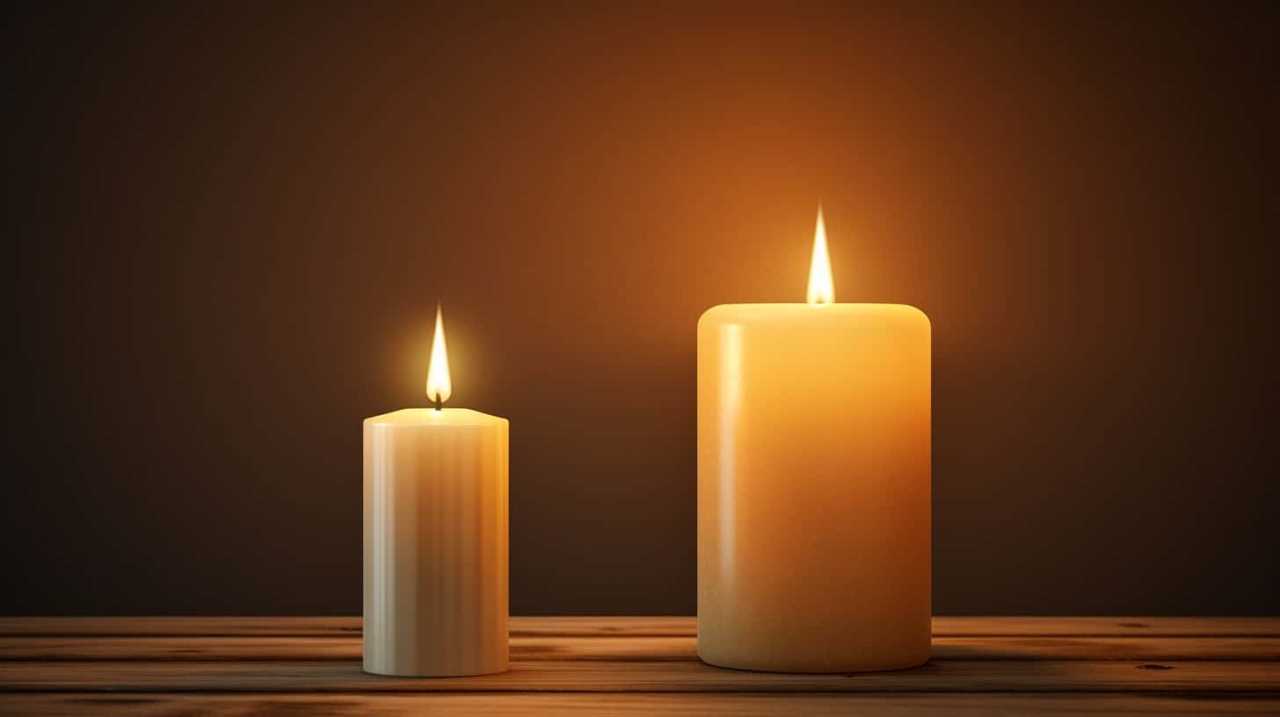
So, let’s dive in and explore the fascinating world of tealight candles together, shall we?
Key Takeaways
- Tealight candles originated in Europe in the 1800s and were initially made by hand using molds and a combination of beeswax and tallow.
- Tealights are now manufactured using automated machinery and the most commonly used material is paraffin wax.
- Tealight candles work by the heat from the flame melting the wax, which is then drawn up the wick and vaporizes when reaching the flame.
- Tealight candles have a standard size of approximately 1.5 inches in diameter and 0.65 inches in height, and they can burn for 3 to 5 hours.
History of Tealight Candles
We will now explore the history of tealight candles. Tealight candles have been around since the 1800s, originating in Europe. Initially, they were made by hand using molds and a combination of beeswax and tallow. However, with advancements in technology, the tealight candle manufacturing process has become more efficient and streamlined.
Today, tealights are manufactured using automated machinery. Paraffin wax, a byproduct of petroleum, is the most commonly used material. The manufacturing process involves melting the wax, adding dyes and fragrances, and pouring the mixture into aluminum or polycarbonate cups.
Tealight candles gained popularity in the 20th century due to their versatility and affordability. They quickly became a staple in homes, restaurants, and spas, providing a soft and ambient light.
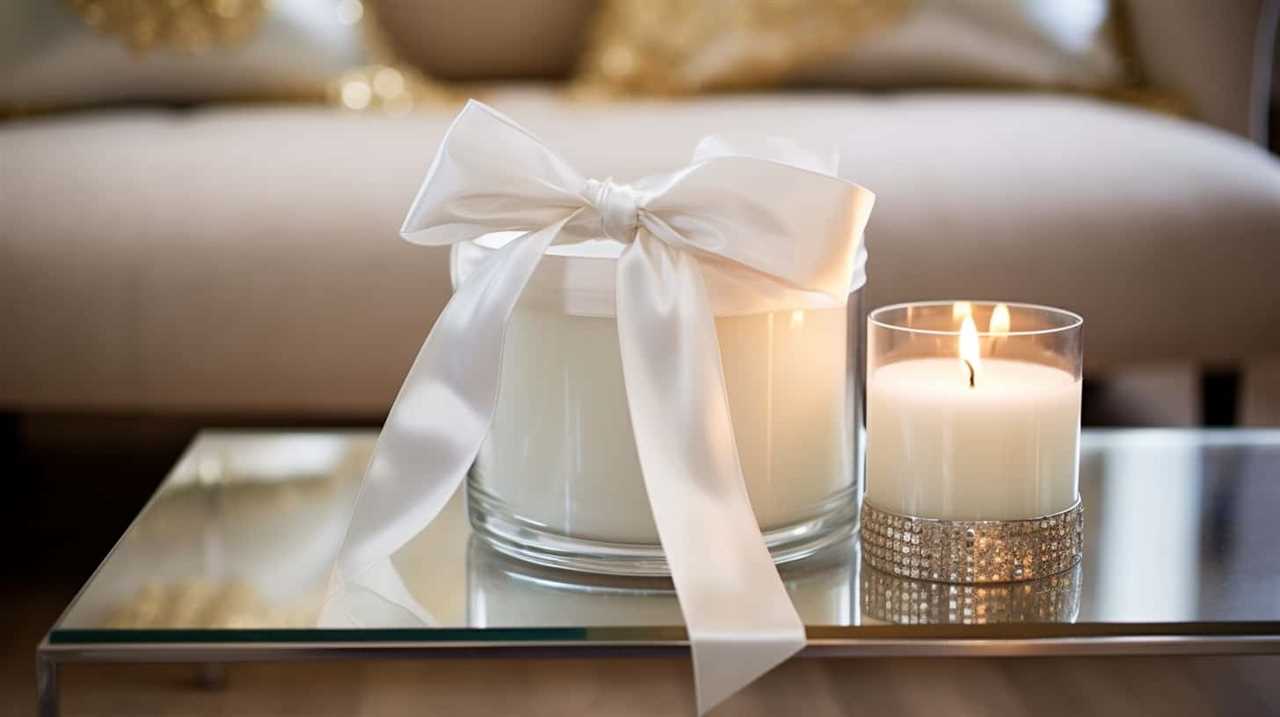
In recent years, there’s been a trend towards eco-friendly tealight candles, made from soy or beeswax, to cater to the environmentally conscious consumer.
What Tealight Candles Are Made of
Tealight candles are typically made of paraffin wax, a byproduct of petroleum. Paraffin wax is widely used in candle manufacturing due to its low cost, availability, and ability to hold fragrance and color.
Here are some key points about the materials used in tealight candle production:
- Paraffin wax: It’s a white, odorless, and solid material derived from petroleum. It has a low melting point, allowing tealights to easily liquefy and release their fragrance.
- Wick: The wick is usually made of cotton or paper, providing a steady and consistent flame when lit.
- Aluminum or polycarbonate cup: This cup holds the melted wax and prevents it from spilling or leaking while the candle burns.
- Dyes and fragrances: To enhance the ambiance, tealight candles are often infused with various colors and scents, providing a soothing experience during meditation.
Using tealight candles for meditation offers several benefits. The soft, flickering light creates a calming atmosphere, helping to induce relaxation and focus. The gentle scent and warm glow can enhance mindfulness and promote a sense of tranquility. Additionally, the portability of tealights allows for easy placement around the meditation space, enhancing the overall experience.
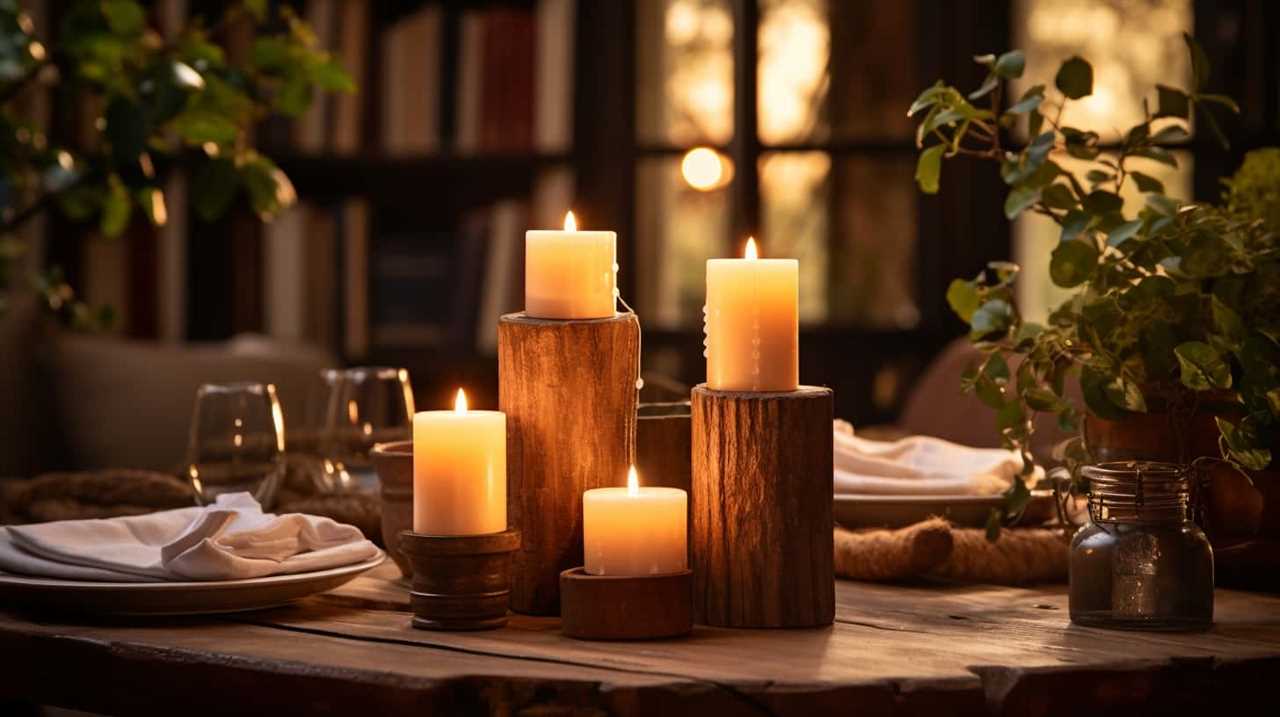
How Tealight Candles Work
The combustion process of tealight candles involves the gradual release of heat and light. When lit, the heat from the flame melts the wax in the candle, which is then drawn up the wick. As the liquid wax reaches the flame, it vaporizes and combines with oxygen in the air, resulting in a chemical reaction that produces heat and light. This process continues as long as there is enough wax to fuel the flame.
Tealight candles are a popular choice for creating a warm and cozy atmosphere, but there are also alternatives available. LED tealight candles provide a flameless option that is safe and reusable. Additionally, scented tealight candles offer the added benefit of filling the room with a delightful fragrance. These candles often contain essential oils or other aromatic substances that can create a relaxing or invigorating ambiance. Whether you prefer traditional tealight candles or explore these alternatives, there are many ways to enjoy the benefits they provide.
| Tealight Candle Alternatives | Benefits of Scented Tealight Candles |
|---|---|
| LED tealight candles | Creates a safe and reusable option |
| Scented tealight candles | Fills the room with a delightful |
| fragrance |
Standard Size and Dimensions of Tealight Candles
Tealight candles typically have a standard size and dimensions of around 1.5 inches in diameter and 0.65 inches in height. These compact dimensions make them perfect for various purposes.
Here are some key facts about tealight candle sizes and dimensions:

- Versatility: Their small size allows tealight candles to fit snugly in most candle holders, making them ideal for decorative purposes.
- Portability: Due to their compact dimensions, tealights are easy to transport, making them great for outdoor events, camping trips, or power outages.
- Burn time: Despite their small size, tealights can burn for a surprising amount of time, usually ranging from 3 to 5 hours.
- Safety: The small dimensions of tealights ensure that they burn safely, with the flame contained within the metal cup.
These dimensions make tealight candles a versatile and practical choice for lighting, decoration, and creating ambiance in various settings.
The Different Types of Tealight Candle Holders
When it comes to tealight candle holders, there are a variety of materials and styles to choose from, each having a unique impact on the ambiance created by the candlelight.
From glass and ceramic to metal and wood, the choice of holder material can greatly influence the overall aesthetic and feel of the space.
Additionally, different styles such as lanterns, votives, and decorative holders offer various levels of protection, versatility, and design options for displaying tealight candles.

Holder Materials and Styles
Exploring the world of tealight candles, we discovered an array of holder materials and styles that add charm to any setting. Whether you’re looking for a sleek and modern design or a more rustic and traditional feel, there are plenty of options to choose from.
Here are some of the most popular candle holder designs and alternative tealight options:
- Glass holders: These transparent holders are versatile and allow the candle’s warm glow to shine through, creating a cozy ambiance.
- Ceramic holders: With their elegant and timeless designs, ceramic holders add a touch of sophistication to any space.
- Metal holders: These durable holders come in various finishes, such as brass or stainless steel, and can withstand high temperatures.
- Wooden holders: Crafted from natural materials, wooden holders provide a warm and earthy feel, perfect for creating a cozy atmosphere.
No matter your style preference, these holder materials and styles are sure to enhance the beauty of your tealight candles and create a welcoming environment.
Impact on Candlelight Ambiance
As we delve into the impact of candlelight ambiance, let’s now explore the different types of tealight candle holders and how they contribute to creating a warm and inviting atmosphere.
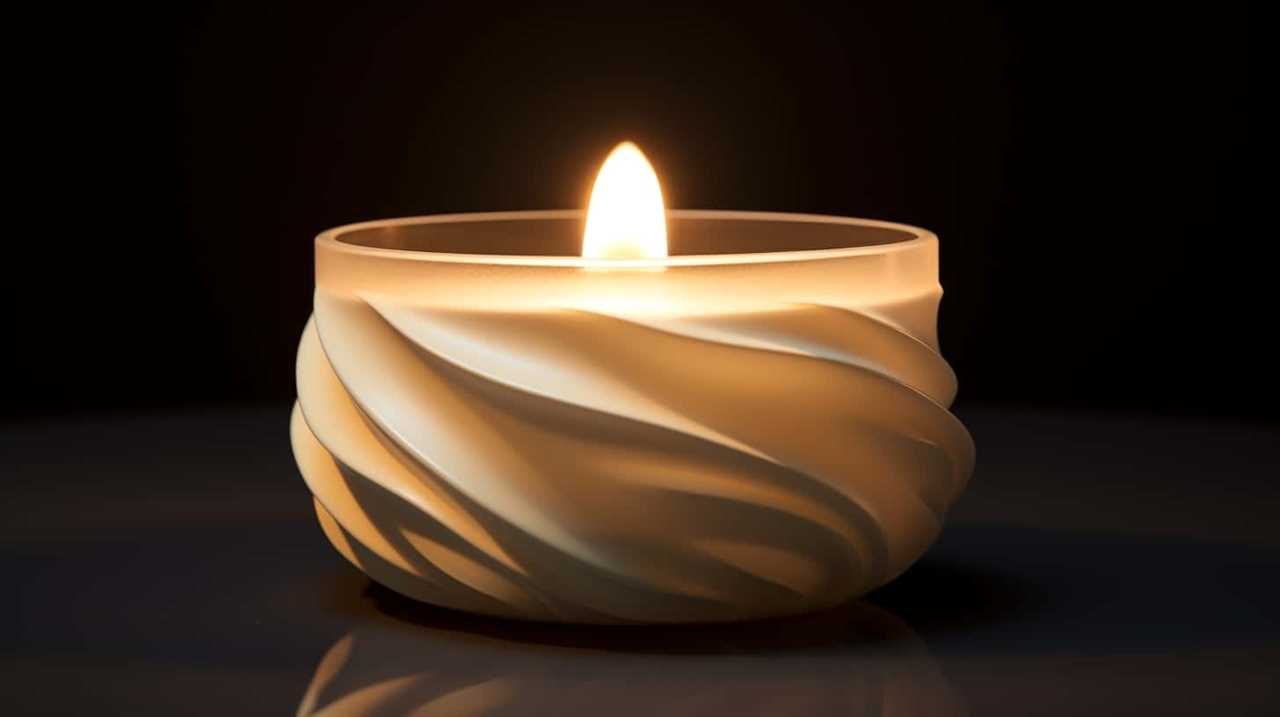
Tealight candle holders come in various materials and styles, each offering unique benefits. Glass holders, for example, enhance the beauty of the flickering flame and create an elegant and sophisticated ambiance. Metal holders, on the other hand, provide a more rustic and cozy feel.
The choice of holder can also affect the quality of light emitted by the candle. Candlelight has a warm, soft glow that’s often preferred over the harshness of electric light. This gentle illumination is especially beneficial for activities like meditation, as it promotes a calming and peaceful atmosphere.
Benefits of Using Tealight Candles
We appreciate the benefits that come from using tealight candles. These small candles offer a variety of advantages, making them a popular choice among candle enthusiasts. Here are some benefits to consider:
- Tealight candle scents: Tealight candles are available in a wide range of scents, from relaxing lavender to invigorating citrus. They not only provide a beautiful ambiance but also fill the room with delightful fragrances.
- Benefits of tealight candle holders: Tealight candles are often placed in holders, which not only enhance their aesthetic appeal but also provide a safe and secure platform for burning. Tealight candle holders prevent any accidental spills or mess and protect surfaces from heat damage.
- Portability: Tealight candles are lightweight and compact, making them easy to transport and use in various settings. Whether you’re hosting a dinner party or enjoying a relaxing bath, tealight candles can create a cozy atmosphere wherever you go.
- Versatility: Tealight candles can be used in a variety of ways, such as in lanterns, floating in water, or as accents in decorative displays. Their versatility allows for endless creative possibilities.
With these benefits in mind, it’s clear why tealight candles are a popular choice. Now, let’s explore some popular uses for tealight candles.
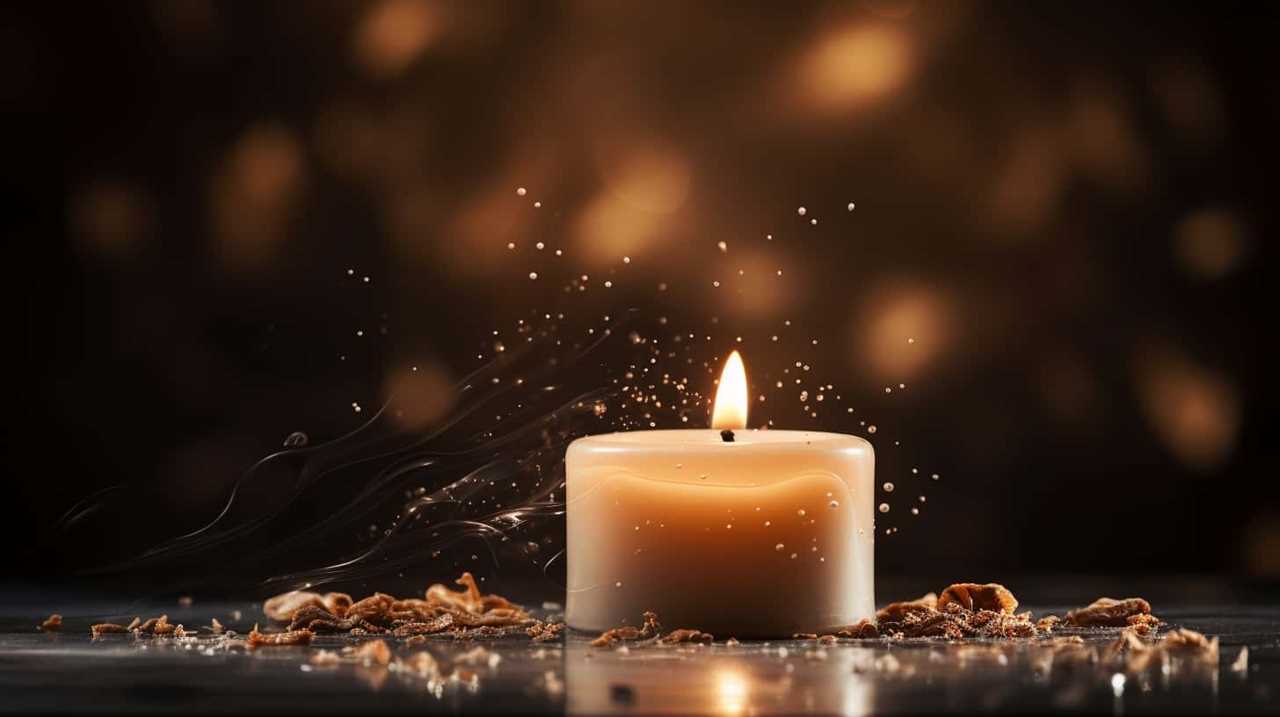
Popular Uses for Tealight Candles
Tealight candles find their place in a myriad of settings, adding a warm and intimate glow to any occasion. Not only are they versatile and affordable, but they also offer endless possibilities for creativity and decoration.
Tealight candle crafts are a popular way to repurpose these small candles. From creating homemade luminaries to decorating glass jars or wine bottles, tealight candles can be transformed into beautiful and unique decor pieces.
Additionally, tealight candles are commonly used as centerpiece ideas. Placed in decorative holders or floating in water-filled bowls, they provide an elegant touch to weddings, parties, and special events.
With their flickering flames and gentle illumination, tealight candles are the perfect choice for adding warmth and ambiance to any setting.

Tealight Candles for Relaxation and Aromatherapy
One popular use for tealight candles is to enhance relaxation and create a soothing ambiance through aromatherapy. Tealight candles come in a variety of scents, each offering its own unique benefits for relaxation.
Here are four reasons why using tealight candles for relaxation can be beneficial:
- Stress Relief: Certain scents, such as lavender or chamomile, have calming properties that can help reduce stress and anxiety.
- Improved Sleep: Burning a tealight candle with a soothing scent like vanilla or jasmine before bedtime can promote a more restful sleep.
- Mood Enhancement: Aromas like citrus or eucalyptus can uplift your mood and create a positive atmosphere.
- Meditation Aid: Lighting a tealight candle with scents like sandalwood or patchouli can help create a tranquil environment for meditation, allowing for a deeper sense of relaxation and focus.
Safety Precautions When Using Tealight Candles
To ensure the safe use of tealight candles, it’s important to take certain precautions.
First and foremost, never leave a burning tealight candle unattended. It’s crucial to always stay in the same room and keep an eye on the candle to prevent any accidents.
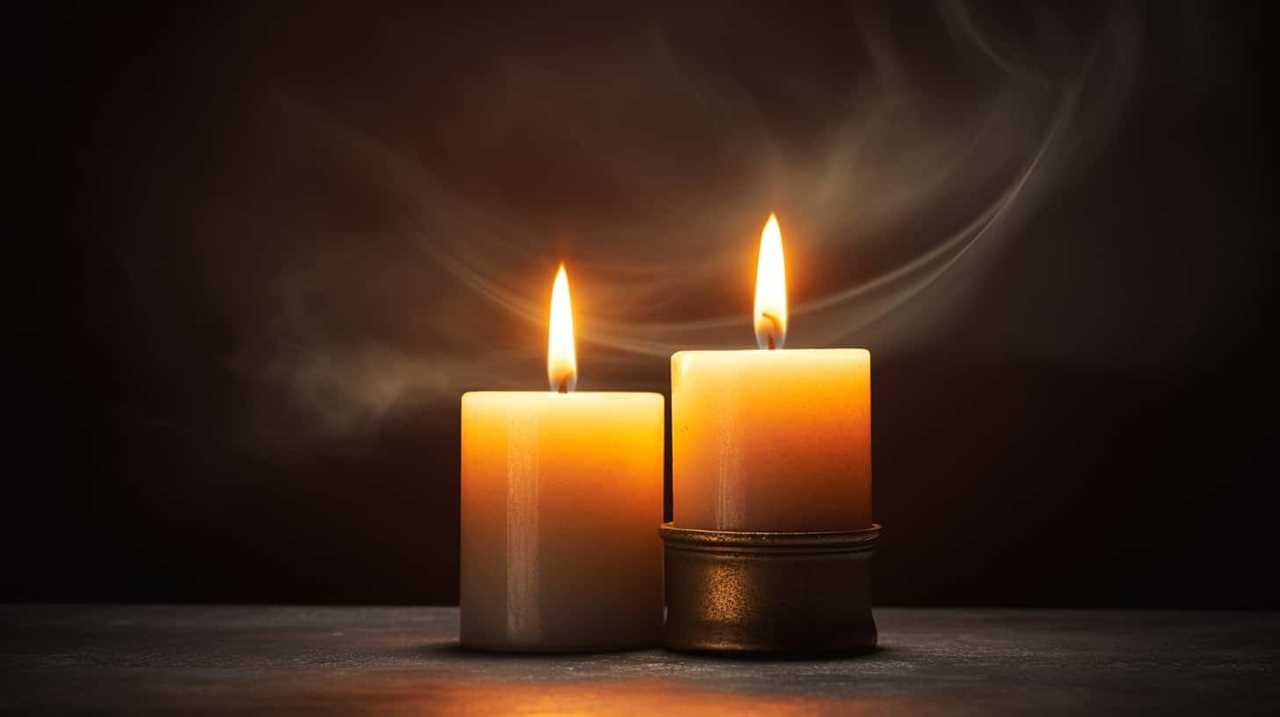
Additionally, make sure to place the tealight candle on a stable and heat-resistant surface to avoid any risk of fire. It’s also advisable to keep the candle away from any flammable materials, such as curtains or paper.
When using tealight candles, it’s essential to have alternative options available, such as LED tealights or flameless candles, which provide a safer alternative without the risk of fire.
Lastly, when storing tealight candles, ensure they’re kept in a cool and dry place, away from any heat sources or direct sunlight.
How to Properly Extinguish Tealight Candles
When extinguishing a tealight candle, we should employ safe and effective methods to prevent any accidents or residual heat from causing potential harm. Here are some guidelines to follow for proper extinguishing of tealight candles:

- Never blow out the candle: Blowing on the flame can cause hot wax to splatter or ignite nearby objects. It’s best to avoid this method.
- Use a candle snuffer: Gently place the snuffer over the flame to extinguish it without any risk of splattering or creating sparks.
- Dip the wick into the melted wax: Use a heat-resistant tool to submerge the wick into the melted wax until it’s completely extinguished.
- Ensure proper tealight candle storage: Store tealight candles in a cool, dry place away from flammable materials. Always keep them in their original containers or in fire-resistant holders.
How Long Do Tealight Candles Burn
Tealight candles burn for a specific duration of time, depending on various factors. It is important to know the burn time of these candles to ensure that they meet your specific needs. The burn time can vary based on the size and quality of the candle, as well as the conditions in which it is burned. To give you an idea of the average burn time for tealight candles, here is a table showcasing the approximate burn times:
| Candle Size | Average Burn Time |
|---|---|
| Standard | 4-6 hours |
| Extended | 7-9 hours |
| Jumbo | 9-12 hours |
To maximize the burn time of your tealight candles, here are some safety tips to keep in mind:
- Always place the candle on a heat-resistant surface.
- Keep the candle away from any flammable materials.
- Trim the wick to 1/4 inch before lighting the candle.
- Never leave a burning candle unattended.
Where to Buy Tealight Candles
We can easily find tealight candles at various retail stores and online platforms. When it comes to purchasing tealight candles, there are several options available to us. Here are some places where you can buy tealight candles:
- Local supermarkets: Many local supermarkets carry a variety of tealight candles in different scents and sizes. They often have affordable prices and a wide selection to choose from.
- Home decor stores: Stores that specialize in home decor often have a dedicated section for candles, including tealights. These stores may offer a range of scents and styles to match your preferences.
- Online marketplaces: Online platforms like Amazon, Etsy, and eBay offer a vast selection of tealight candles with different scents and prices. Shopping online gives you the convenience of comparing prices and reading customer reviews.
- Craft stores: Craft stores like Michaels and Hobby Lobby also carry tealight candles. These stores may offer unique scents and even DIY kits to make your own scented tealights.
Whether you prefer the convenience of online shopping or enjoy browsing the aisles of a physical store, finding tealight candles in various scents and at different price points is easy and accessible.
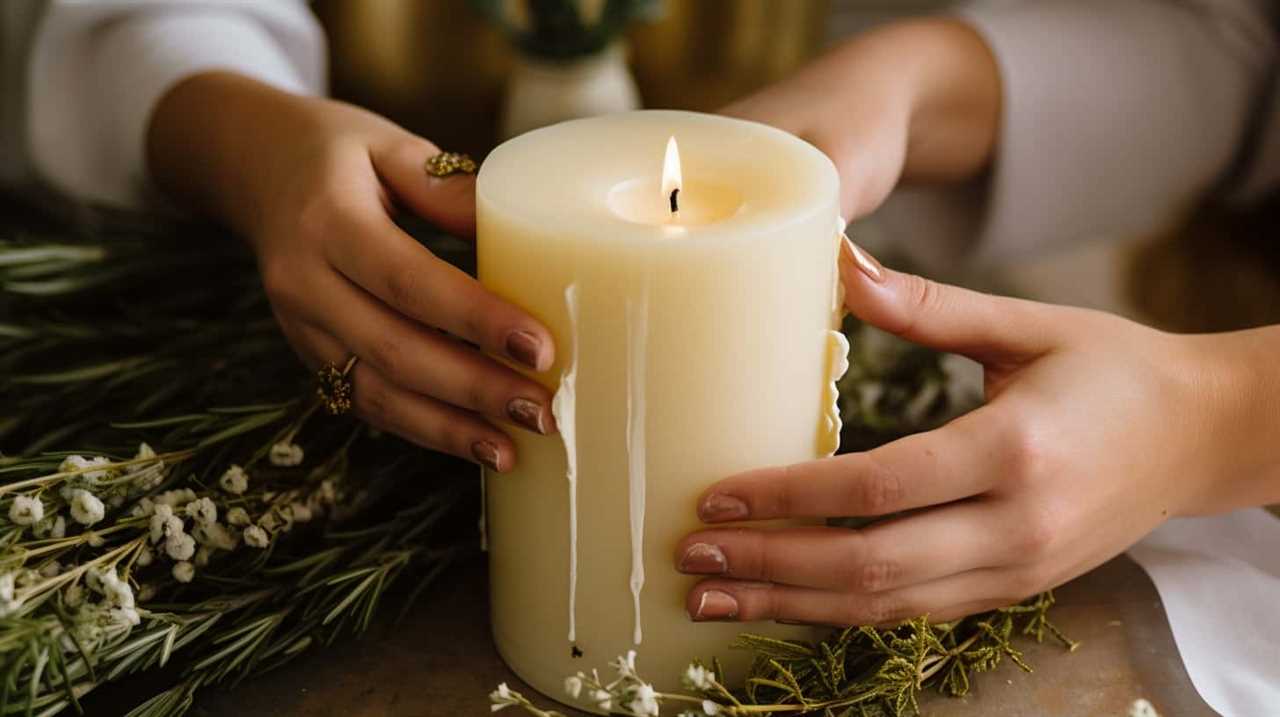
DIY Tealight Candle Ideas
Let’s talk about some creative ways to decorate tealight candles and make them unique.
We can explore different ideas for tealight holders that will add a special touch to our home decor.
Additionally, we can also discuss ways to recycle tealight candles and give them new life.
Creative Tealight Decoration
For those looking to add a touch of ambiance to their homes, there are countless ways to get creative with tealight candles. These small candles can be used in a variety of craft projects and can serve as stunning centerpieces for any occasion.
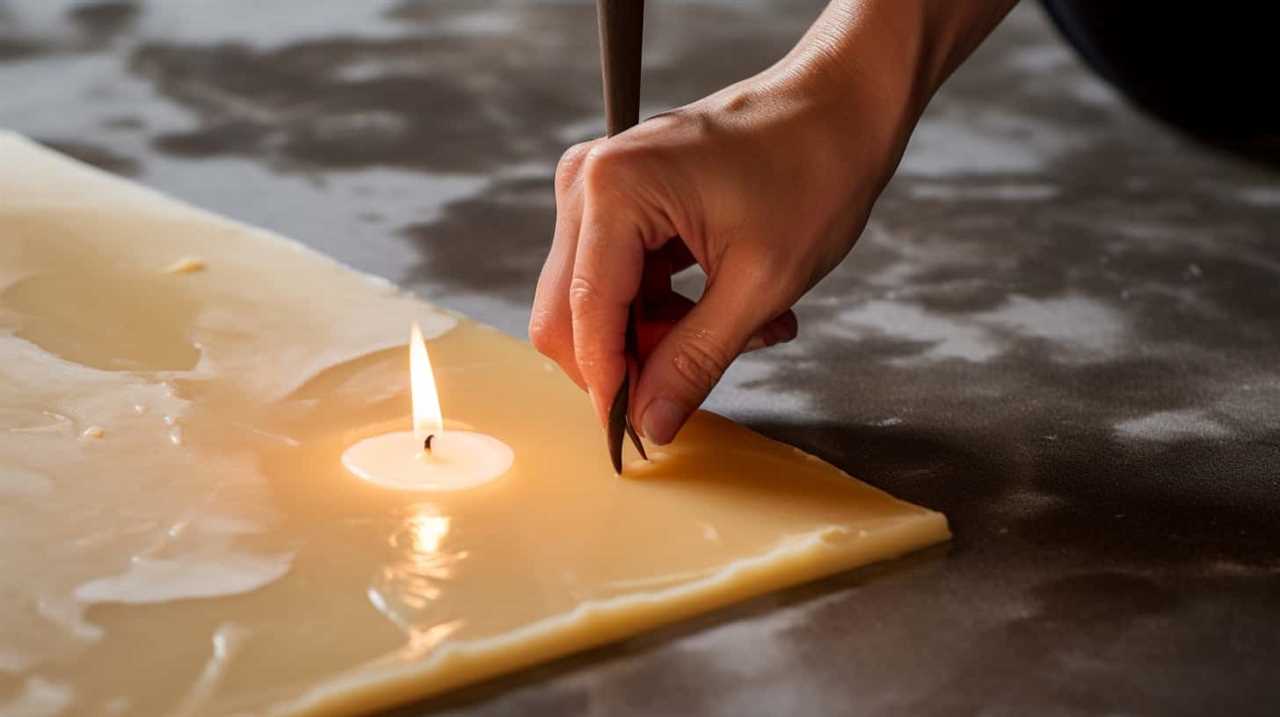
Here are a few ideas to inspire your tealight candle crafts:
- Mason Jar Lanterns: Place a tealight candle inside a mason jar and decorate the jar with ribbons, lace, or paint. The soft glow of the candle will create a warm and cozy atmosphere.
- Floating Candle Bowls: Fill a glass bowl with water and float tealight candles on the surface. Add flower petals or small decorative items for an elegant touch.
- Wine Bottle Candle Holders: Cut the bottom of a wine bottle and place a tealight candle inside. The bottle acts as a stylish and unique candle holder.
- Tealight Candle Wreaths: Create a wreath using wire or twigs and attach small tealight candles to it. Hang it on your door or use it as a centerpiece for a festive occasion.
Get creative with your tealight candles and transform your home into a cozy and welcoming space.
Unique Tealight Holders
To explore unique tealight holders and DIY tealight candle ideas, we can start by discussing creative ways to enhance the ambiance of your home.
Choosing the right tealight holder can have a significant impact on the candlelight ambiance in your living space. One option is to use unusual materials like glass jars, mason jars, or even wine glasses to hold your tealight candles. These unconventional holders not only provide a unique and stylish look but also create interesting patterns and reflections when the candlelight dances through the glass.

Another idea is to repurpose old objects such as teacups, seashells, or vintage lanterns as tealight holders. These one-of-a-kind pieces add a touch of nostalgia and charm to any room.
Tealight Recycling Ideas
Tealight candles can be repurposed in creative and eco-friendly ways by incorporating them into DIY projects. Instead of throwing away used tealight candles, consider giving them a new life with these tealight recycling ideas:
- Tealight Candle Lanterns: Remove the metal casing from used tealight candles and place them in glass jars or lanterns. Light them up to create a cozy and enchanting atmosphere.
- Tealight Candle Holders: Melt down the leftover wax from used tealight candles and pour it into silicone molds to create unique candle holders. Add a wick and let it cool for a personalized touch.
- Tealight Candle Wax Melts: Collect the leftover wax from used tealight candles and melt it in a wax warmer. Enjoy the soothing fragrance without the open flame.
- Tealight Candle Decorations: Use the metal casings from used tealight candles as decorative accents. Paint them, string them together, or attach them to other items to create eye-catching crafts.
With these tealight candle crafts, you can repurpose your used tealight candles and reduce waste while adding a touch of creativity to your home decor.
Tealight Candles for Special Occasions and Events
Tealight candles are commonly used to create a warm and intimate ambiance during special occasions and events. Their small size makes them perfect for creating beautiful arrangements that can enhance the overall atmosphere of any gathering.

Tealight candle arrangements can be as simple as placing them in a row along the center of a table or as elaborate as incorporating them into floral displays or floating them in water-filled bowls. The flickering light of tealights adds a touch of magic to weddings, dinner parties, and other celebrations.
To further elevate the experience, scented tealight candles can be used to infuse the air with delightful fragrances. From soothing lavender to refreshing citrus, the wide variety of scents available allows you to customize the ambiance to suit the occasion and create a memorable experience for your guests.
Frequently Asked Questions
Are Tealight Candles Safe to Use in Small Spaces or Enclosed Areas?
Tealight candles are safe to use in small spaces or enclosed areas. They provide a soft, flickering light that creates a cozy atmosphere. However, there are tealight candle alternatives that offer the same benefits without the risk of an open flame.
Can Tealight Candles Be Used Outdoors?
Can tealight candles be used outdoors? Absolutely! They are perfect for outdoor tealight candle holders, providing a warm and inviting ambiance. Plus, the benefits of using tealight candles outdoors include added lighting and a cozy atmosphere.
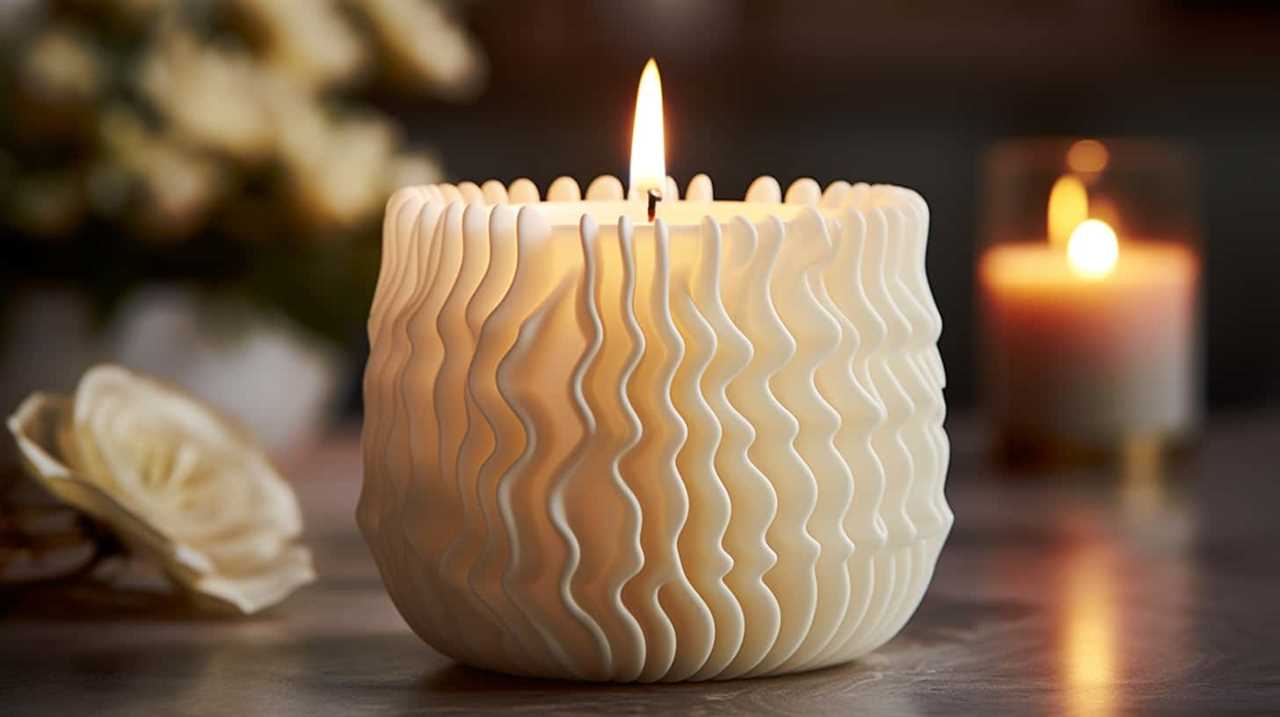
How Long Do Tealight Candles Typically Last?
Tealight candles typically last between 4 to 6 hours. Factors affecting burn time include the type and quality of wax, wick size, and environmental conditions. It’s important to consider these factors when planning for events or outdoor activities.
What Are Some Creative Ways to Decorate With Tealight Candles?
When it comes to finding creative ways to decorate with tealight candles, we’ve got you covered. From repurposing tealight candles to DIY candle holders, we’ll show you how to add a touch of warmth and elegance to any space.
Are There Any Specific Scents or Fragrance Options Available for Tealight Candles?
Scent options and fragrance choices for tealight candles include a wide range of options such as lavender, vanilla, and citrus. These scents can create a calming ambiance, uplift moods, or add a refreshing touch to any space.
Conclusion
In conclusion, tealight candles are a versatile and popular choice for adding ambiance and warmth to any space. With their compact size and long burn time, these candles are perfect for special occasions or everyday use.

Whether you’re looking for a romantic atmosphere or creating a cozy environment, tealight candles are a reliable option. Remember, ‘A candle loses nothing by lighting another candle’ – spreading light and positivity is always a good idea.
I’m Jane and I love candles. I have candles everywhere in my house–in every room, on every surface. I love the smell of candles, and I love how they make my place feel warm and cozy.
Candles are really important to me. They help me relax and de-stress after a long day. They remind me of happy memories, and they make me feel calm and peaceful. I can’t imagine my life without candles!
Candles
What Is a Tapered Candle

Have you ever noticed the captivating glow of a slim candle? Let us illuminate you on these remarkable creations.
Tapered candles are not just ordinary candles; they are a symbol of elegance and sophistication. With their slender and graceful form, they effortlessly transform any occasion into a magical experience.
We, as candle enthusiasts, are passionate about sharing our knowledge and expertise on all things tapered candles. In this guide, we will explore the history, characteristics, types, and even creative uses for tapered candles.
We will also provide valuable tips on how to properly burn and care for these exquisite candles.

So, join us on this illuminating journey and discover the enchantment of tapered candles.
Key Takeaways
- Tapered candles have a long history, dating back thousands of years, and became popular in the 18th century.
- They come in various shapes, sizes, and colors, making them a versatile and popular choice for special events and occasions.
- The type of wax and wick used can impact burn time and quality, with beeswax offering a clean-burning flame and paraffin having a shorter burn time.
- Tapered candles can serve as both decorative and functional elements in home decor, adding elegance and sophistication to any room.
History of Tapered Candles
We will now explore the history of tapered candles.
The history of candle making dates back thousands of years, with evidence of early candle-like objects found in ancient Egyptian tombs. However, it wasn’t until the Middle Ages that the production of candles became more widespread.
During this time, candles were primarily made from animal fat or beeswax. The evolution of candle shapes began with simple cylindrical forms, but as time went on, candle makers started to experiment with different shapes and sizes.

Tapered candles, with their distinctive conical shape, became popular in the 18th century. These elegant candles were often used in formal settings and added a touch of sophistication to any occasion.
Today, tapered candles continue to be a beloved choice for those who desire to create a warm and welcoming atmosphere.
Characteristics of Tapered Candles
Tapered candles come in a variety of shapes, ranging from straight and cylindrical to elegant and curvy. These different shapes allow for a range of decorative options, making them a popular choice for special events and occasions.
Additionally, the burning time of tapered candles can vary depending on factors such as size and wax composition, providing flexibility for different lighting needs.
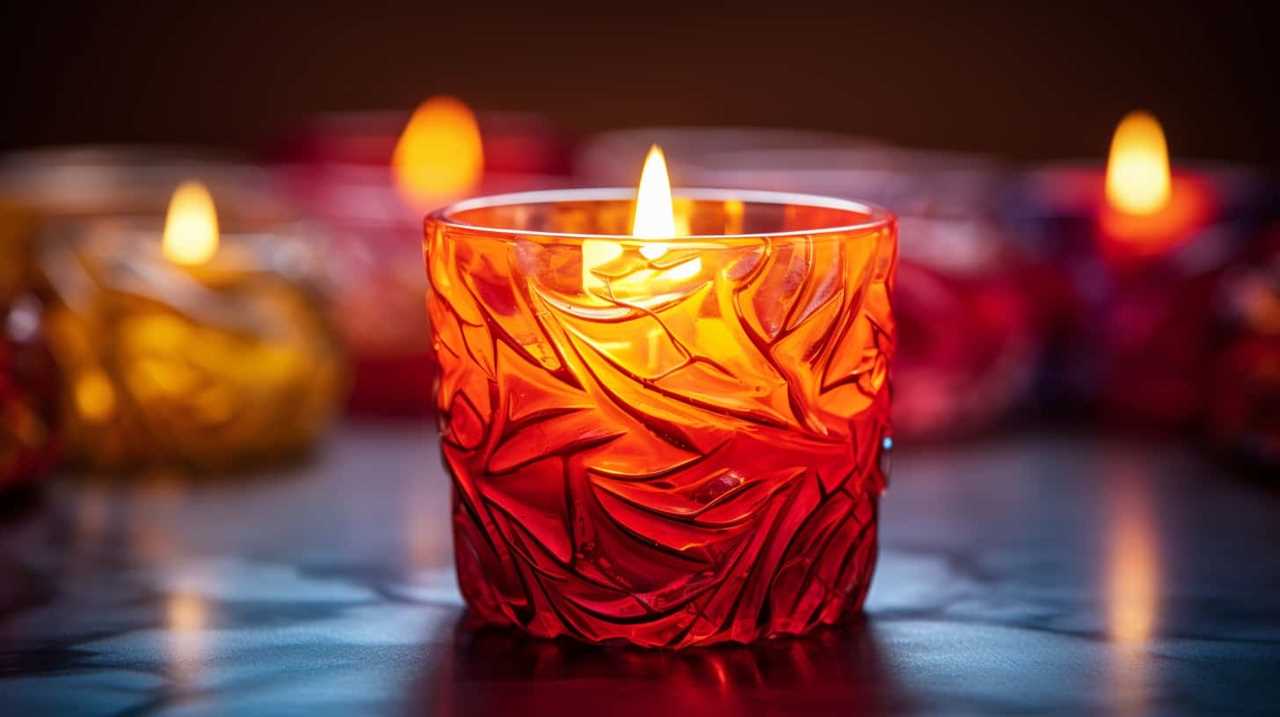
Tapered Candle Shapes
Discussing the shapes of tapered candles, we will explore their distinct characteristics. Tapered candles come in various shapes, each with its own unique style and purpose. To help you understand these shapes better, let’s take a look at the table below:
| Shape | Description |
|---|---|
| Standard | A classic shape that narrows gradually from the base to the tip, fitting most candlestick holders. |
| Spiral | These candles feature a spiral design, adding an elegant touch to any candle arrangement. |
| Twisted | With a twisted design, these candles create a visually interesting and dynamic centerpiece. |
These different shapes give tapered candles versatility and allow them to fit into various candlestick holders or taper candle holders. Whether you’re looking to create a romantic ambiance or add a touch of sophistication to your space, tapered candles in different shapes can help you achieve your desired aesthetic.
Candle Burning Time
As we delve into the characteristics of tapered candles, it’s important to consider their candle burning time. The burning time of tapered candles can vary depending on several factors, including the size, quality, and burning techniques used.
Here are some key points to keep in mind when it comes to candle burning time:

- Proper wick trimming: Trimming the wick to about ¼ inch before lighting the candle can help to maximize its burning time.
- Avoiding drafts: Placing the candle in a draft-free area can prevent it from burning faster than usual.
- Using candle accessories: Candle accessories like candle snuffers can help extinguish the flame without causing excess smoke or wax splatter.
By implementing these candle burning techniques and maximizing the lifespan of tapered candles, you can enjoy their warm glow for a longer period.
Now, let’s move on to discussing the different types of tapered candles.
Different Types of Tapered Candles
When it comes to different types of tapered candles, there are a few key points to consider.
First, the wax and wick used can impact the burn time and quality of the candle.
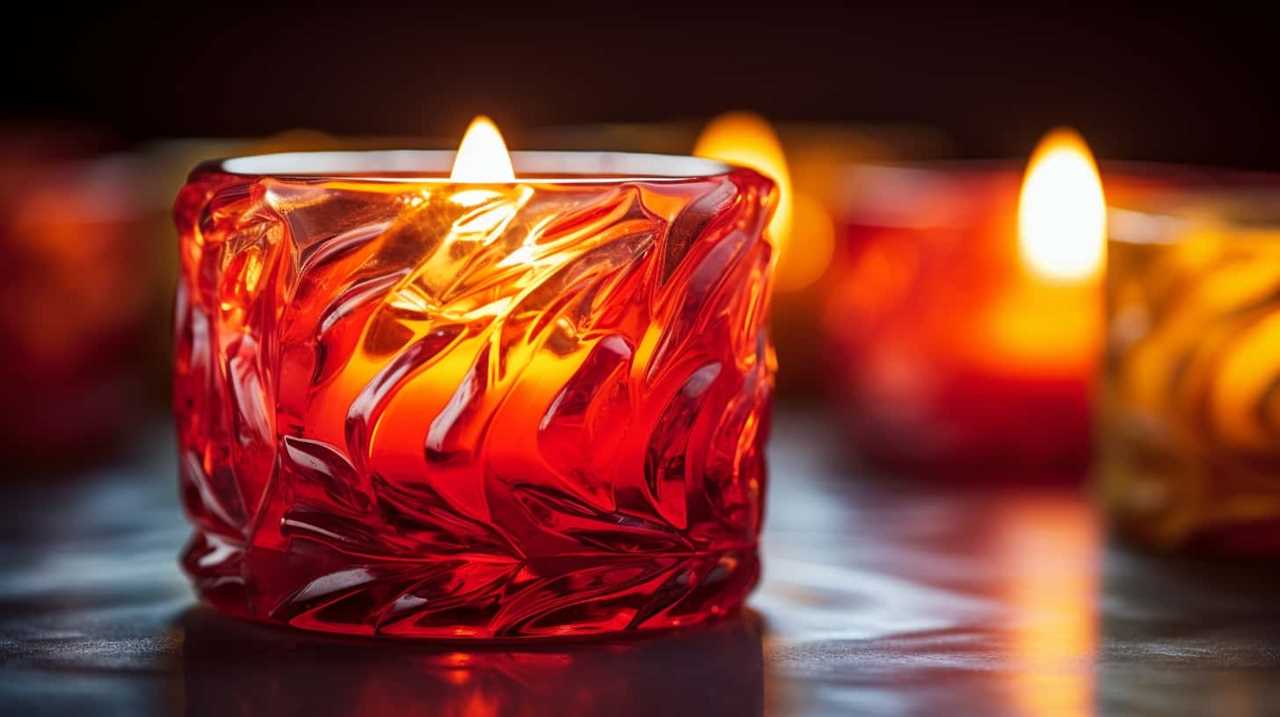
Second, the colors and sizes available offer a wide range of options to suit different preferences and occasions.
Lastly, tapered candles can serve both decorative and functional purposes, making them versatile for various settings.
Wax and Wick
We will now explore the various types of wax and wick used in tapered candles.
When it comes to wax types, there are a few common options to consider:
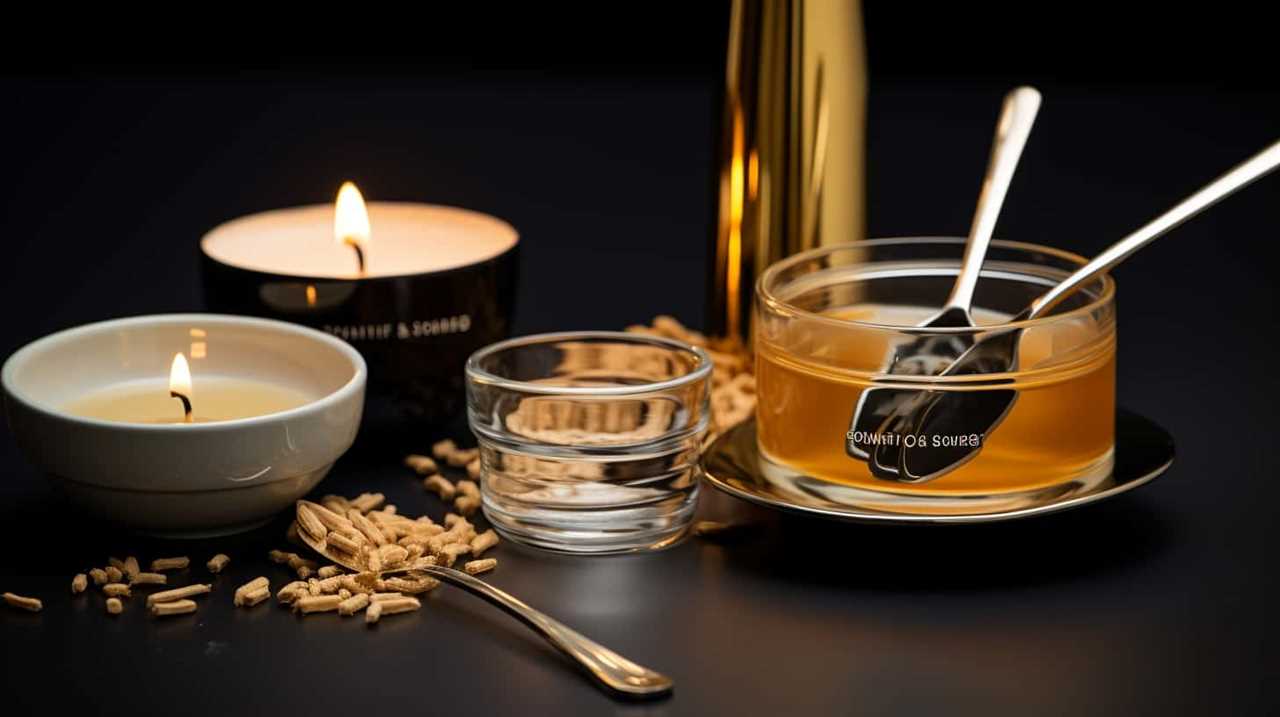
- Beeswax: This natural wax is known for its sweet, honey-like scent and clean-burning properties. It produces a warm, golden flame that adds a touch of elegance to any setting.
- Paraffin: This widely available wax is derived from petroleum and is commonly used in mass-produced candles. It offers a wide range of colors and scents, but it tends to produce more soot and has a shorter burn time compared to other wax types.
Now let’s move on to the wick materials:
- Cotton: This is the most commonly used wick material. It’s known for its clean burn and minimal smoke. It provides a steady flame and is suitable for most taper candles.
- Wooden wicks: These wicks add a unique touch to tapered candles. They create a soothing crackling sound reminiscent of a fireplace, enhancing the ambiance and creating a cozy atmosphere.
Colors and Sizes
Tapered candles come in a wide variety of colors and sizes to suit different preferences and occasions. When it comes to candle colors, you can find everything from classic white and ivory to vibrant reds, blues, and greens. There are also pastel shades like pink, lavender, and mint for a softer and more romantic ambiance.
As for candle sizes, they range from shorter taper candles that are around 6 inches in height to longer ones that can reach up to 18 inches or more. Some tapered candles also come in different diameters, allowing you to choose a size that fits perfectly in your candle holders.
With such a diverse range of colors and sizes available, you can easily find the perfect tapered candles to complement your decor or set the mood for any occasion.

Decorative or Functional?
Our tapered candles can serve both a decorative and functional purpose in your home. They aren’t only beautiful to look at but also provide a warm and inviting ambiance.
Here are two ways our taper candles can enhance your space:
- Decorative: When placed in candlestick holders, tapered candles can become the centerpiece of any table setting or mantelpiece. They come in various colors and sizes, allowing you to match them with your home decor and create a visually appealing display. The flickering flame adds an element of elegance and sophistication to any room.
- Functional: Taper candles aren’t just for show; they also provide a practical lighting solution. In the event of a power outage or during a cozy evening at home, having taper candle holders with lit tapered candles can create a soothing and intimate atmosphere. They can be used as emergency lighting or for creating a calming ambiance during a relaxing bath or dinner.
Incorporating our taper candles into your home decor can bring both beauty and functionality to your space.
How Tapered Candles Are Made
To create tapered candles, craftsmen carefully shape and mold wax into slender forms using specialized tools and techniques.

The candle making process begins with melting the wax, which can be made from various materials such as beeswax, paraffin, or a blend of both.
Once the wax is melted, it’s poured into a mold specifically designed for tapered candles. The mold is usually made of metal and has a conical shape.
The wax is left to cool and harden, and once it reaches the right consistency, the mold is removed, revealing the beautifully tapered candle.
The craftsmen then trim the wick and polish the candle to give it a smooth and elegant finish.

Now, let’s explore the popular materials used for tapered candles.
Popular Materials Used for Tapered Candles
We will now explore the different popular materials used for creating tapered candles. When it comes to the candle making process, there are various types of waxes that are commonly used. Here are two sub-lists to help you understand the options available:
- Natural Waxes:
- Beeswax: This traditional choice is known for its natural sweet scent and clean burn. It also emits negative ions that can purify the air.
- Soy Wax: Made from soybean oil, this renewable resource is eco-friendly and produces a slow, clean burn. It’s also known for holding fragrance well.
- Paraffin-based Waxes:
- Paraffin Wax: This widely used wax is affordable and has good scent throw. However, it isn’t eco-friendly as it’s derived from petroleum.
- Palm Wax: A sustainable alternative to paraffin, palm wax is made from palm oil. It has a unique crystalline appearance and excellent burn quality.
The Meaning and Symbolism of Tapered Candles
Tapered candles hold significant meaning and symbolism in various cultures and traditions. Throughout history, these candles have been used for religious, ceremonial, and decorative purposes.
The history of taper candles dates back to ancient times, where they were predominantly made from beeswax or animal fat. The shape of tapered candles, with a wider base and a narrow tip, allows for a slow and even burn. This shape isn’t only practical but also carries symbolic significance.

The gradual decrease in size represents the journey of light, from darkness to illumination. In addition to the traditional long and slim shape, tapered candles can also be found in various other shapes, such as spiral or twisted designs. These unique shapes add an artistic element to the candles and enhance their symbolic meaning.
With their rich history and diverse shapes, tapered candles bring a sense of tradition, spirituality, and beauty to any space. Transitioning into the next section, let’s explore how these candles can be incorporated into home decor.
Tapered Candles in Home Decor
How can tapered candles enhance the ambiance of our homes?
Tapered candles aren’t only a functional source of light but also a beautiful decorative element that can transform any space. Here are some decorating ideas to inspire you:

- Create a centerpiece on your dining table by placing a group of tapered candles in different heights in elegant taper candle holders. The soft glow of the candles will add a romantic and intimate atmosphere to your meals.
- Use tapered candles to create a cozy and inviting atmosphere in your living room. Place them on a mantel or coffee table, and let their flickering light create a warm and relaxing ambiance.
- Incorporate tapered candles in your bathroom decor for a spa-like experience. Place them around the bathtub or on a vanity tray to create a serene and soothing atmosphere.
By incorporating tapered candles into your home decor, you can create a warm and inviting space that promotes relaxation and comfort.
Now let’s explore how tapered candles can elevate special occasions.
Tapered Candles for Special Occasions
When it comes to special occasions, tapered candles are a timeless choice. These candles come in a variety of shapes, sizes, and colors, allowing you to find the perfect match for your event.
Whether you’re decorating a wedding reception, setting the mood for a romantic dinner, or celebrating a milestone birthday, tapered candles add a touch of elegance and sophistication to any occasion.
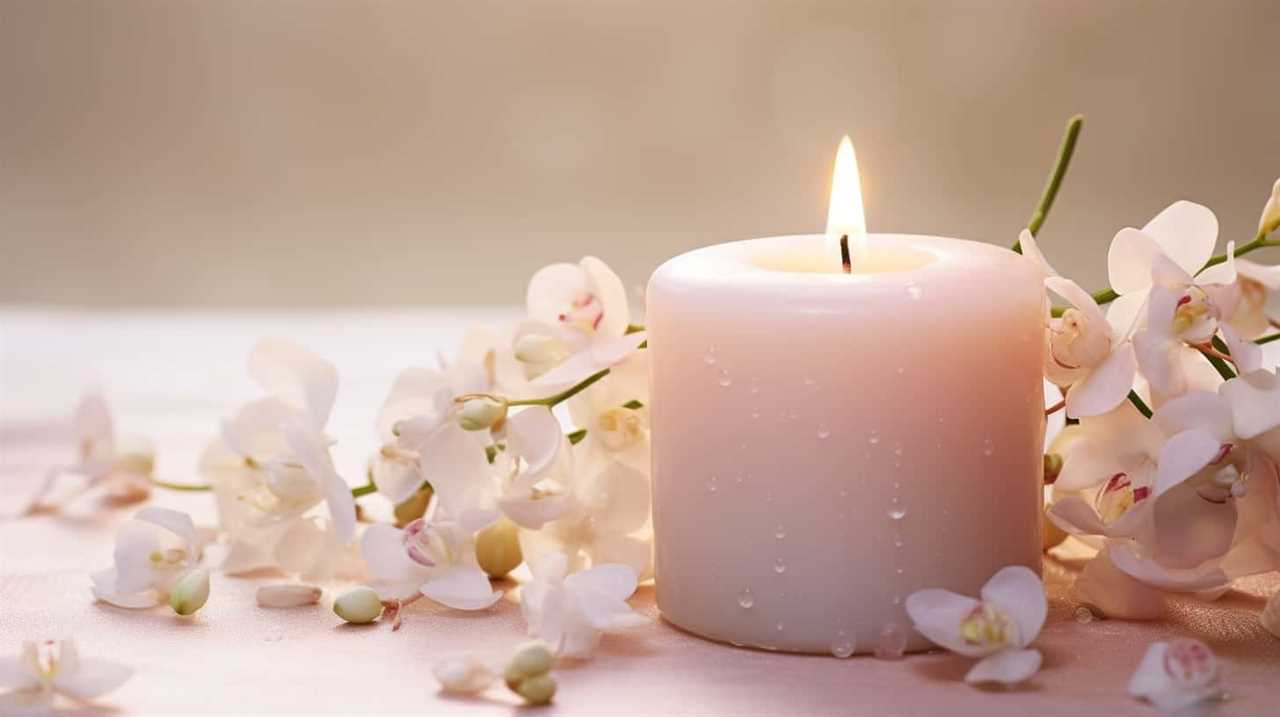
Tapered Candle Varieties
For special occasions, we prefer to use a variety of tapered candles. When it comes to choosing the perfect candles for these moments, there are a few options to consider.
• Decorative vs. Plain Tapered Candles:
- Decorative tapered candles add an elegant touch to any event. They come in various colors and designs, allowing you to match them with your decor and create a cohesive look.
- Plain tapered candles, on the other hand, offer simplicity and understated beauty. They’re perfect for minimalist or classic settings, where their clean lines and smooth texture can enhance the ambiance.
• Scented Tapered Candles:
- Scented tapered candles add another layer of sensory delight to your special occasion. With a wide range of fragrances available, you can choose one that complements the theme or evokes a particular mood.
Whether you opt for decorative or plain tapered candles, or prefer the added scent of scented varieties, these candles will undoubtedly enhance the atmosphere and create a memorable experience for your guests.

Decorating With Tapered Candles
We typically use a variety of tapered candles when decorating for special occasions, including weddings, parties, and celebrations. Tapered candles are a versatile choice for decoration due to their elegant and sleek design. They come in various lengths, colors, and scents to suit different decorating styles.
When it comes to displaying tapered candles, there are numerous options for candle holders available. You can opt for classic and simple holders made of glass or metal, or choose more elaborate and decorative ones to enhance the ambiance. Candle holders can be placed individually or arranged in clusters to create a stunning centerpiece.
The flickering flame of tapered candles adds a warm and inviting atmosphere to any special occasion, making them a popular choice for decoration.
Now, let’s explore the symbolism of tapered candles.
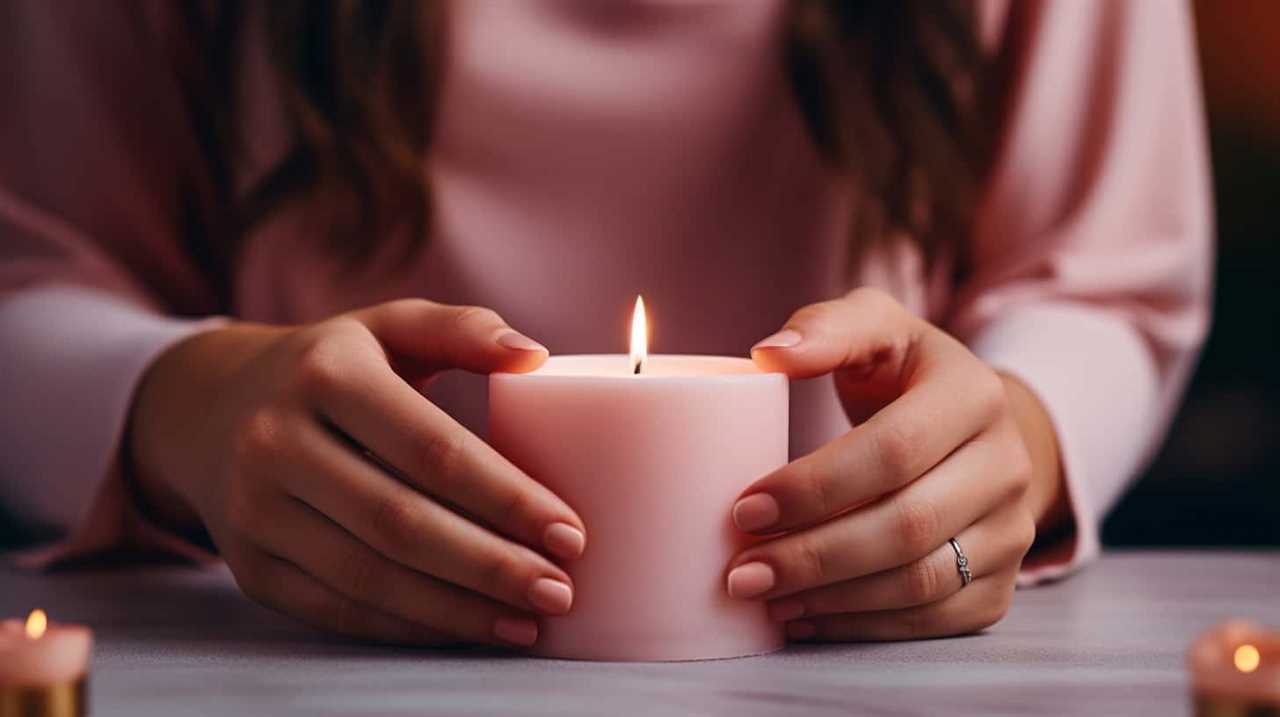
Symbolism of Tapered Candles
During special occasions, we often use tapered candles to enhance the ambiance and create a warm and inviting atmosphere. These candles hold great symbolism and significance, adding depth and meaning to our celebrations.
Here is what makes tapered candles special:
- Elegance and Sophistication: Tapered candles symbolize elegance and sophistication, elevating any event or gathering to a higher level of refinement.
- Unity and Togetherness: The act of lighting tapered candles represents unity and togetherness, as the flame from one candle can be used to ignite others, symbolizing the sharing of light and love.
- Special Moments: Tapered candles are often used during special moments like weddings, anniversaries, and religious ceremonies, symbolizing the sacredness and significance of these occasions.
- Hope and Renewal: The gentle flickering flame of a tapered candle signifies hope and renewal, reminding us to stay positive and embrace new beginnings.
Tips for Decorating With Tapered Candles
When decorating with tapered candles, it’s important to consider the size and color of the candles to create an elegant and cohesive look.
To start, consider the height of the candle in relation to the surrounding decor. If you have high ceilings or tall centerpieces, longer tapered candles can create a dramatic effect. On the other hand, shorter candles work well for low-profile arrangements.
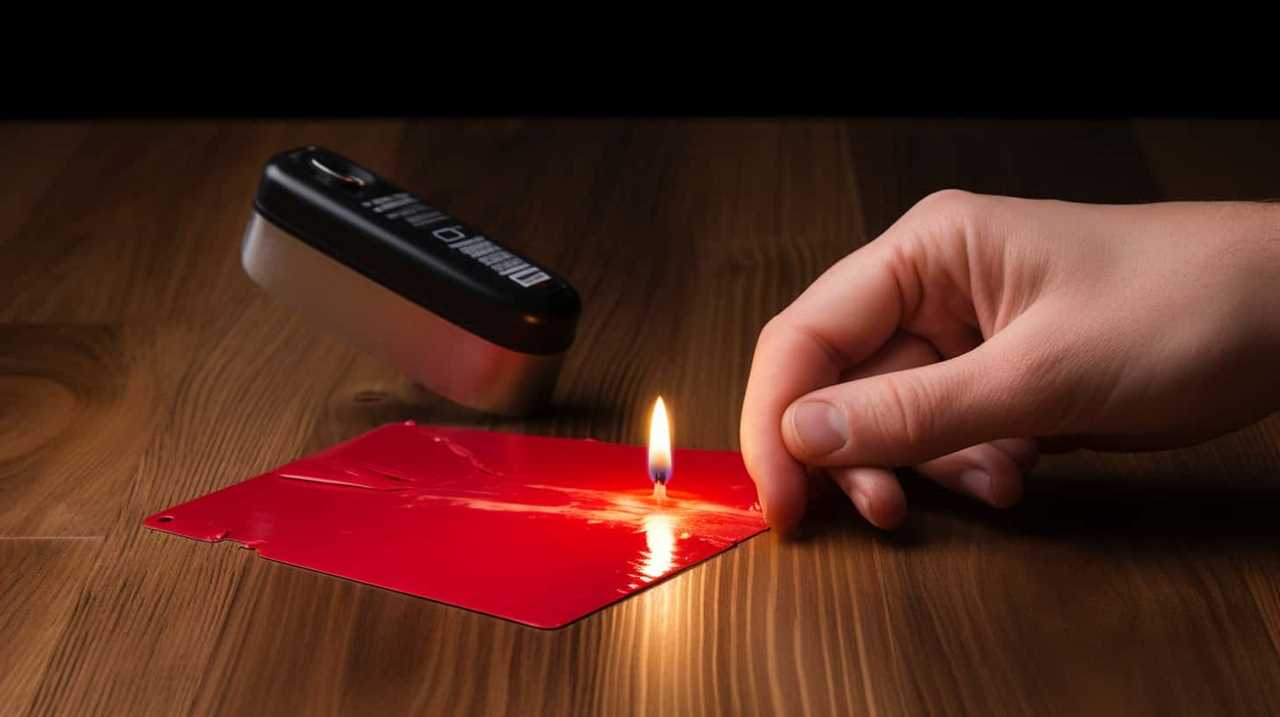
Additionally, think about the color of the candles. White or ivory candles are classic and versatile, while colored candles can add a pop of color and complement a specific theme or color scheme.
To display your tapered candles, consider using candlestick holders. These holders come in a variety of styles and materials, such as metal, glass, or ceramic, allowing you to find the perfect match for your decor.
Benefits of Using Tapered Candles
Using tapered candles as a centerpiece adds an elegant touch to any table setting. Their slim and elongated shape creates a visually stunning display, especially when placed in a candlestick holder.
Additionally, tapered candles are incredibly versatile and can be used for any occasion, whether it’s a formal dinner party or a cozy night in. Not only do they enhance the ambiance with their warm and flickering glow, but they also provide a practical source of lighting.
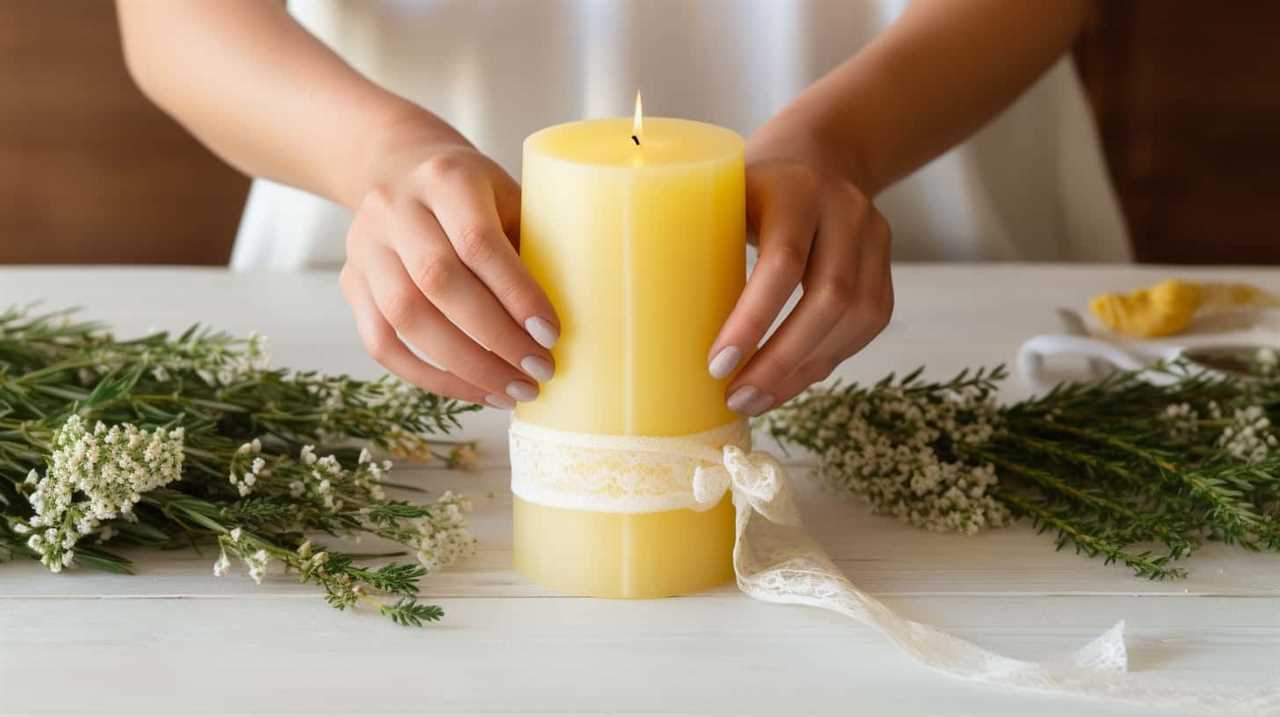
Elegant Candlestick Centerpiece
We prefer using tapered candles for our elegant candlestick centerpiece because they create a sophisticated and refined ambiance. Tapered candles add an elegant touch to any home decor, making them the perfect choice for creating a stunning centerpiece.
Here are some benefits of using tapered candles for your elegant candlestick centerpiece:
- Enhances the Atmosphere: The soft, flickering glow of tapered candles creates a warm and inviting atmosphere, perfect for intimate gatherings or romantic dinners.
- Adds Height and Drama: Tapered candles come in various lengths, allowing you to create a visually striking centerpiece with varying heights and sizes, adding drama and interest to your table setting.
- Creates a Sense of Grandeur: The tall and slender shape of tapered candles exudes elegance and sophistication, making them a popular choice for formal occasions and special events.
- Brings Focus to the Table: Placing tapered candles in candlestick holders draws attention to the centerpiece, making it the focal point of your table decor.
With their timeless beauty and ability to transform any space, tapered candles are a perfect choice for creating an elegant candlestick centerpiece that will impress your guests and elevate your home decor.
Versatile for Any Occasion
Tapered candles offer versatility for any occasion, enhancing the ambiance with their elegant glow and creating a captivating centerpiece for your table. These candles are a must-have in home decor, as they can be used in a variety of settings and events. Whether you’re hosting a formal dinner party or enjoying a cozy evening at home, tapered candles add a touch of sophistication and warmth to your surroundings.

Here are some different occasions where tapered candles can be used:
| Occasion | Description |
|---|---|
| Dinner Parties | Create an intimate and romantic atmosphere for your guests. |
| Weddings | Add an elegant and timeless element to your wedding decor. |
| Holidays | Enhance the festive spirit with the soft glow of tapereds. |
| Birthdays | Celebrate milestones with candles that make a statement. |
| Relaxation | Unwind and create a serene environment for self-care nights. |
No matter the occasion, tapered candles are a versatile choice that can elevate the atmosphere and create a memorable experience for you and your guests.
Provides Ambient Lighting
When using tapered candles, the soft and warm ambiance they create adds a touch of elegance to any setting. The gentle flickering of the flame creates a cozy and intimate atmosphere, perfect for romantic dinners or relaxing evenings at home.
Tapered candles can be placed in various candle holders, allowing you to customize the lighting to suit your taste and decor. The ambient lighting provided by tapered candles can help create a calming and soothing environment, making them ideal for meditation or unwinding after a long day.

Additionally, the soft glow of the candles can enhance the beauty of your surroundings, highlighting the intricate details of your furniture and adding a warm glow to your space.
As we explore the benefits of using tapered candles, it’s important to understand how to properly burn them to ensure safety and maximize their lifespan.
How to Properly Burn Tapered Candles
To burn tapered candles properly, it’s important to follow a few key steps.
First, always trim the wick to about 1/4 inch before lighting the candle. This helps prevent excessive smoke and ensures a clean, even burn.

Next, place the candle in a sturdy holder to prevent it from tipping over. It’s also important to burn tapered candles on a heat-resistant surface, away from any flammable materials.
Before lighting the candle, make sure there are no drafts in the room, as this can cause uneven burning.
Once lit, allow the candle to burn for at least one hour, or until the wax has melted evenly across the entire surface.
Remember to never leave a burning candle unattended and always keep it out of reach of children and pets.
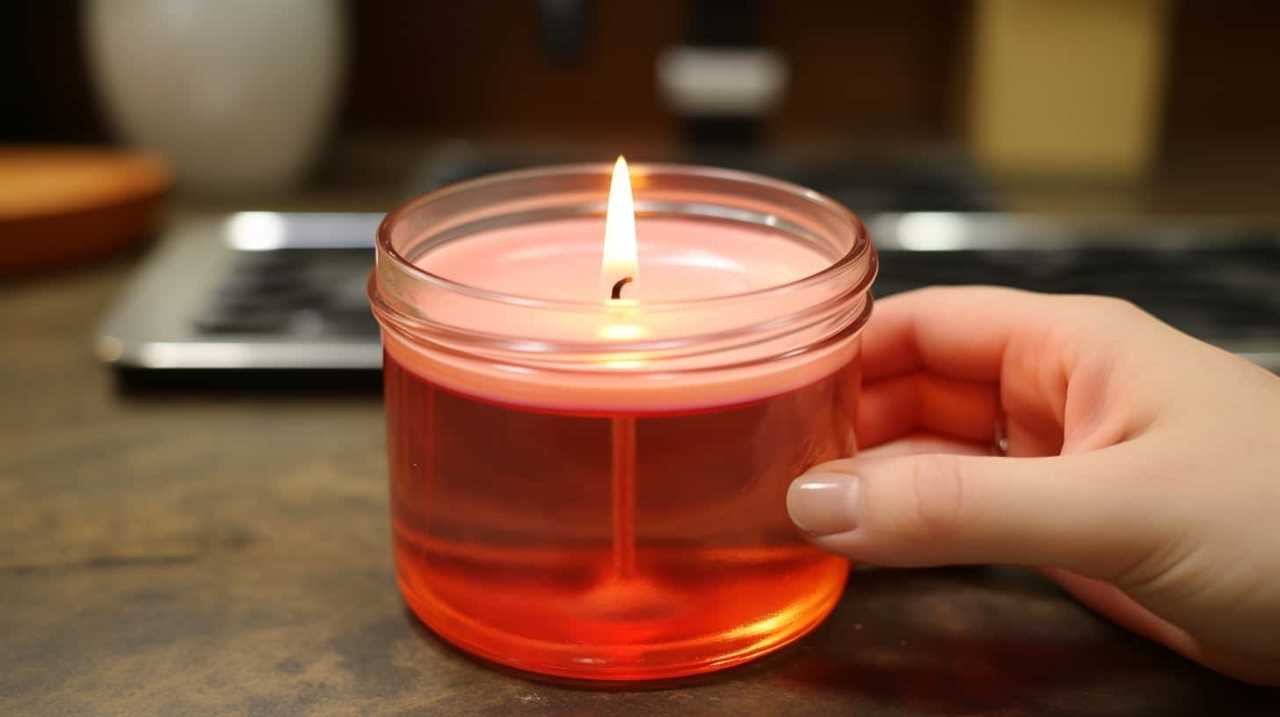
Caring for Tapered Candles
Taking proper care of tapered candles is essential for maintaining their quality and ensuring a longer lifespan. To ensure your candles stay in pristine condition, here are some candle care tips that will help prevent candle drips:
- Trim the wick: Before each use, ensure the wick is trimmed to about 1/4 inch. This will help prevent excessive dripping and uneven burning.
- Place in a draft-free area: Avoid placing tapered candles in areas with drafts as it can cause the flame to flicker and increase the chances of drips.
- Use a candle drip catcher: Consider using a drip catcher to collect any excess wax and prevent it from dripping onto your surfaces.
By following these candle care practices, you can enjoy the beauty of tapered candles without worrying about messy drips.
Now, let’s explore some creative uses for tapered candles to add a touch of elegance to your space.
Creative Uses for Tapered Candles
As we explore the creative uses for tapered candles, it’s important to consider the various ways in which they can enhance the ambiance of any space.

Tapered candle arrangements can be a beautiful centerpiece for a dining table, adding a touch of elegance to any meal. They can also be used to create a romantic atmosphere in a bedroom or a cozy feel in a living room.
To showcase these versatile candles, unique tapered candle holders can be used. These holders come in various shapes and designs, allowing for endless creativity and personalization. Whether it’s a sleek metal holder or a whimsical ceramic one, the right holder can elevate the beauty of a tapered candle.
Now that we’ve explored the creative uses for tapered candles, let’s move on to where you can find them.
Where to Buy Tapered Candles
We found three reliable online retailers where you can buy tapered candles. These retailers offer a variety of buying options and carry some of the best brands in the market. Here are the options we recommend:

- Candle Delights: This online retailer offers a wide range of tapered candles in different sizes, colors, and scents. They prioritize customer satisfaction and provide detailed product descriptions to help you make the right choice. Their prices are competitive, and they often have special promotions and discounts.
- The Candle Emporium: Known for their high-quality products, The Candle Emporium is a great place to find premium tapered candles. They’ve a wide selection of brands and styles, ensuring you’ll find exactly what you need. With their easy-to-navigate website and excellent customer service, your buying experience will be smooth and enjoyable.
Frequently Asked Questions
How Long Do Tapered Candles Typically Burn For?
Tapered candles typically burn for several hours, depending on the size and quality of the wax. Factors such as wax density and wick thickness can affect burn time. It’s important to choose candles made from high-quality wax for longer-lasting enjoyment.
Are Tapered Candles Safe to Use in Outdoor Settings?
Outdoor safety precautions should be taken when using tapered candles. They provide a charming ambiance and are ideal for outdoor settings. However, ensure they are placed in stable holders to prevent accidents or damage from wind.
Can Tapered Candles Be Used as Emergency Lighting?
Tapered candles can serve as emergency lighting due to their long burn time and steady flame. They provide an alternative source of light during power outages or outdoor emergencies. The benefits include their portability, affordability, and ability to create a calming ambiance.
Are There Any Specific Storage Requirements for Tapered Candles?
When it comes to storing tapered candles, it’s important to consider the proper storage conditions. Keeping them in a cool, dry place, away from direct sunlight, will help preserve their quality and prevent any melting mishaps.
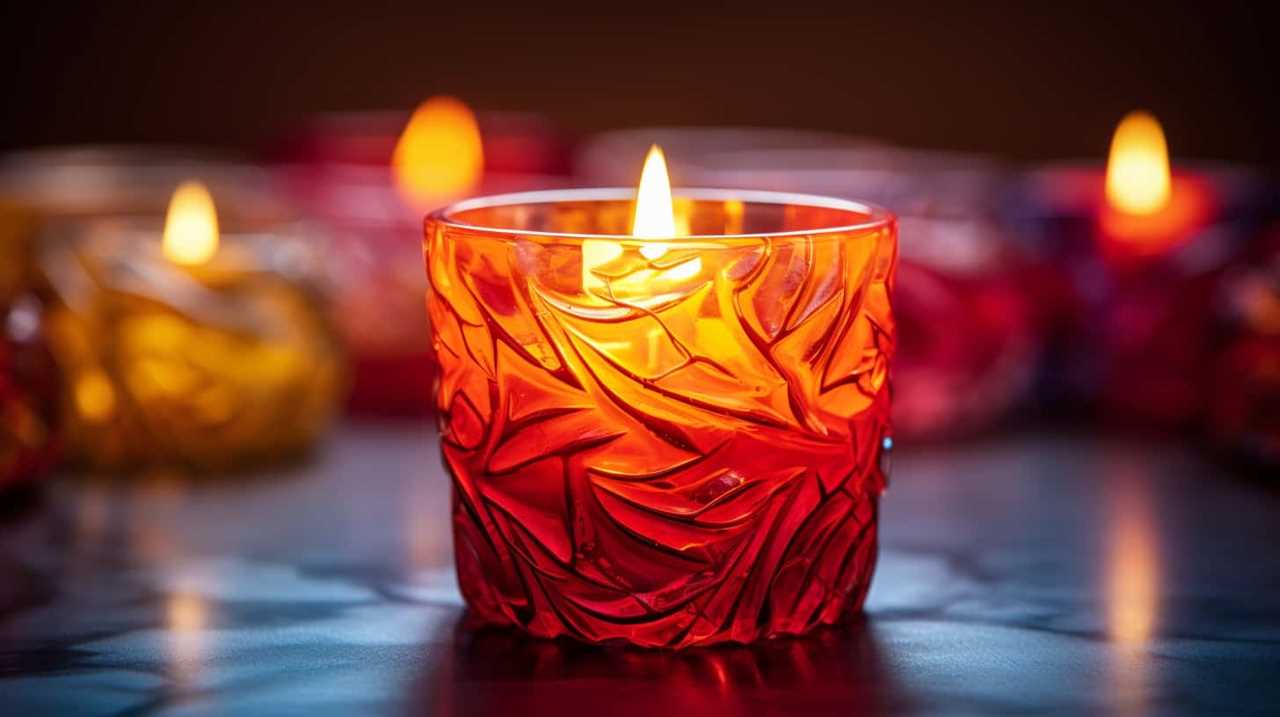
Can Tapered Candles Be Used in Religious Ceremonies or Rituals?
In religious ceremonies, tapered candles hold cultural significance. They are used to symbolize various elements and carry out specific rituals. Their flickering flames create an ambiance of reverence and spirituality, enhancing the overall experience for worshippers.
Conclusion
In conclusion, tapered candles aren’t just ordinary candles; they’re elegant and sophisticated additions to any space. Their slender and gradually narrowing shape adds visual appeal and creates a sense of grace and poise.
Whether used for decoration, ambiance, or rituals, tapered candles bring a touch of timeless beauty and romance.
So, next time you’re looking to create a warm and enchanting atmosphere, consider adding some tapered candles to your collection.

I’m Jane and I love candles. I have candles everywhere in my house–in every room, on every surface. I love the smell of candles, and I love how they make my place feel warm and cozy.
Candles are really important to me. They help me relax and de-stress after a long day. They remind me of happy memories, and they make me feel calm and peaceful. I can’t imagine my life without candles!
Candles
What Is Candle Power

Have you ever thought about the enchanting glow given off by a basic candle? It’s fascinating to witness how a small flame can light up a room, providing both warmth and light.
At our service, we believe in understanding the power behind every flicker, and that’s why we’re here to shed light on the concept of candle power.
Candle power, in simple terms, refers to the brightness of a candle. But it’s more than just a measure of illumination; it’s a beacon of comfort, ambiance, and guidance.
In this guide, we’ll explore the historical origins, scientific measurements, and practical applications of candle power.
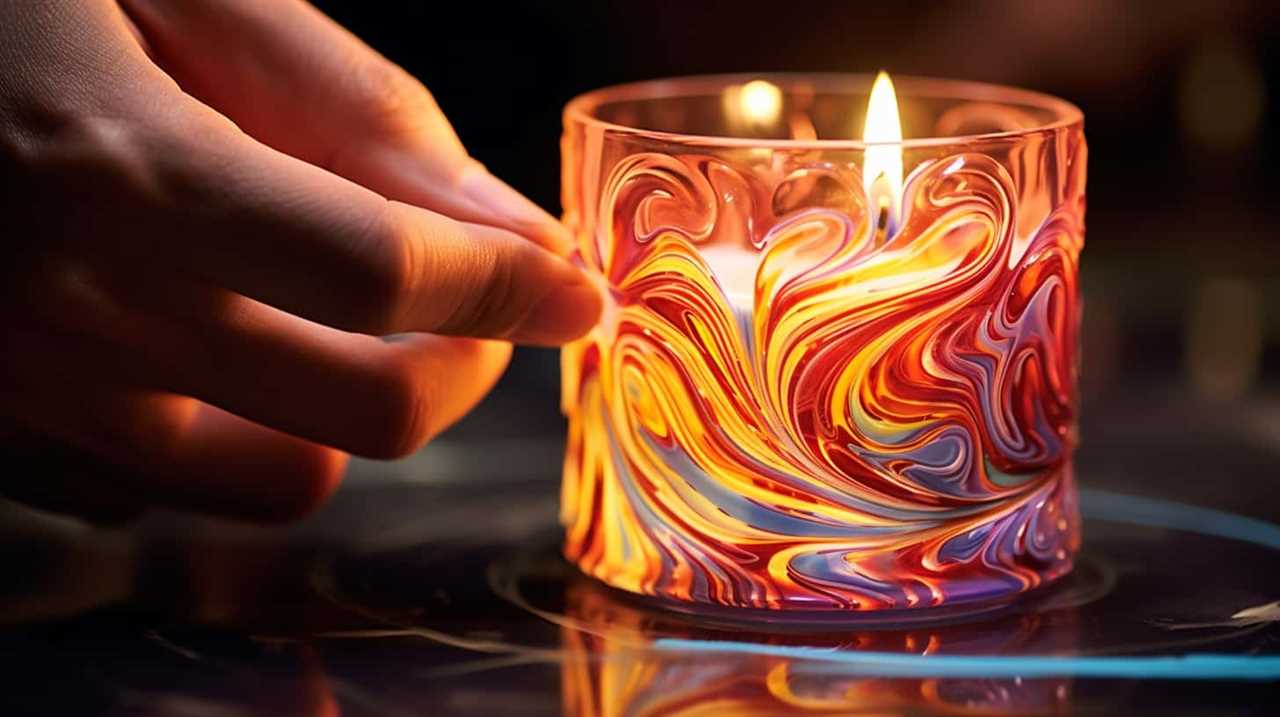
So, let’s embark on this enlightening journey together and uncover the secrets behind the captivating world of candle power.
Key Takeaways
- Candle power is a measurement unit that quantifies the brightness of a light source, allowing for comparisons between different light sources.
- It is used to determine the intensity of light emitted by a candle or any other artificial light source, and understanding candle power helps in providing adequate lighting for various tasks and environments.
- Factors affecting candle power include the wattage of the light source, the distance from the source, and obstructions or reflections in the environment.
- Candle power played a crucial role in the development of electric lighting, influenced architectural design and artistic expression, and continues to be important in various practical applications such as photography and automotive lighting systems.
The Definition of Candle Power
Candle power is a measurement unit that quantifies the brightness of a light source. It’s used to determine the intensity of light emitted by a candle or any other artificial light source. Candle power units, also known as candela, are the standard metric used to measure the luminous intensity of a light bulb or lamp.
The candle power measurement allows us to compare the brightness of different light sources and choose the most suitable one for our needs. By understanding the candle power of a light source, we can ensure that we provide adequate lighting for various tasks and environments.
Now that we’ve covered the definition of candle power, let’s move on to the historical origins of this measurement unit.
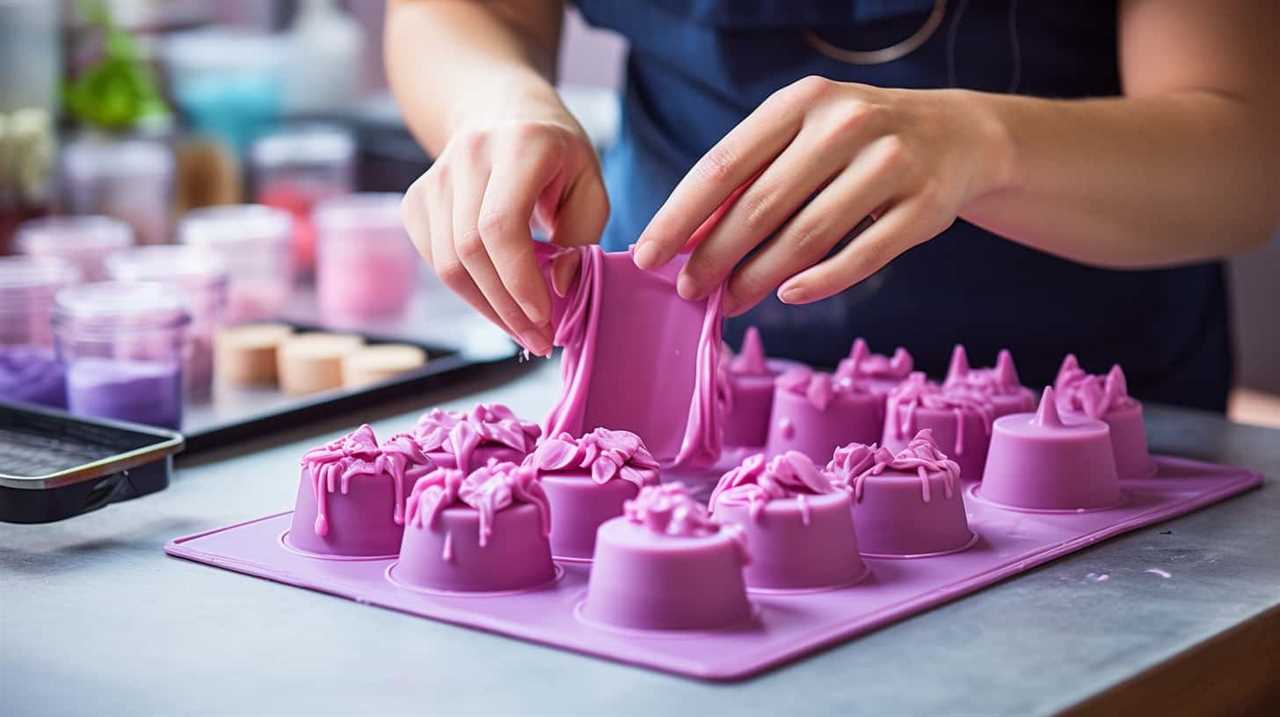
Historical Origins of Candle Power
Continuing from our previous discussion on the definition of candle power, let’s delve into the historical origins of this measurement unit. Understanding the invention timeline and cultural significance of candle power can provide valuable insights into its development and usage.
- Invention Timeline:
- 1838: Scottish inventor James David Forbes introduced the concept of candle power as a measure of light intensity.
- 1860s: British physicist Sir William Thomson (Lord Kelvin) refined the measurement by using a standard sperm candle.
- 1893: The International Commission on Illumination (CIE) established the formal definition of candle power.
- Cultural Significance:
- Candle power allowed for standardized measurement of light sources, enabling accurate comparisons and advancements in lighting technology.
- It played a crucial role in the development of electric lighting, as candle power measurements provided a benchmark for brightness.
- Candle power measurements also influenced architectural design and created new possibilities for artistic expression through lighting.
Understanding the historical origins of candle power helps us appreciate the progress made in lighting technology and its impact on various aspects of our lives.
How Candle Power Relates to Brightness
As we explore the concept of candle power further, it is important to understand how this measurement relates to the overall brightness of a light source. Candle power is a unit that quantifies the light output of a source, specifically the amount of light emitted in all directions. When we talk about candle brightness, we are essentially referring to the intensity or strength of the light produced. To better grasp this relationship, let’s take a look at the table below:
| Candle Power | Light Output (Lumens) |
|---|---|
| 1 | 12.57 |
| 10 | 125.7 |
| 100 | 1257 |
In the table, you can see that as the candle power increases, so does the light output. For instance, a light source with a candle power of 100 will emit approximately 1257 lumens of light. This means that the higher the candle power, the brighter the light source. Understanding this correlation can help us make informed decisions when choosing lighting options to meet our specific needs.

The Science Behind Measuring Candle Power
When it comes to measuring candle power, there are various techniques used to determine light intensity. These techniques include:
- Photometry
- Radiometry
- Spectrophotometry
Factors that affect candle power include:
- The wattage of the light source
- The distance from the source
- Any obstructions or reflections in the environment.
Understanding these measurement techniques and factors is crucial in accurately assessing the brightness of a light source.
Light Intensity Measurement Techniques
To understand the science behind measuring candle power, we’ll explore various light intensity measurement techniques. These techniques are essential in determining the amount of light emitted by a source, and they play a crucial role in many industries and applications.

Here are three commonly used techniques:
- Photometry: This technique measures the intensity of visible light by using a photometer, which compares the light output of a source to a standard reference. It provides accurate measurements in terms of luminous intensity and is widely used in lighting design and evaluation.
- Radiometry: Radiometers are used to measure the total power of light, including both visible and non-visible wavelengths. This technique is particularly useful in applications that require measuring the total light energy emitted by a source, such as solar energy studies.
- Spectroradiometry: Spectroradiometers measure the intensity of light at different wavelengths, providing a detailed spectral distribution. This technique is widely used in colorimetry, where the color properties of light sources are analyzed and evaluated.
Factors Affecting Candle Power
Let’s delve into the factors that impact candle power, shedding light on the science behind measuring this crucial light intensity.
When it comes to measuring candle power, there are several key factors to consider. One important factor is the type and condition of the light source. For example, a new and well-maintained bulb will produce a higher candle power than an old or damaged one.
Another factor is the distance between the light source and the object being illuminated. As the distance increases, the candle power decreases.
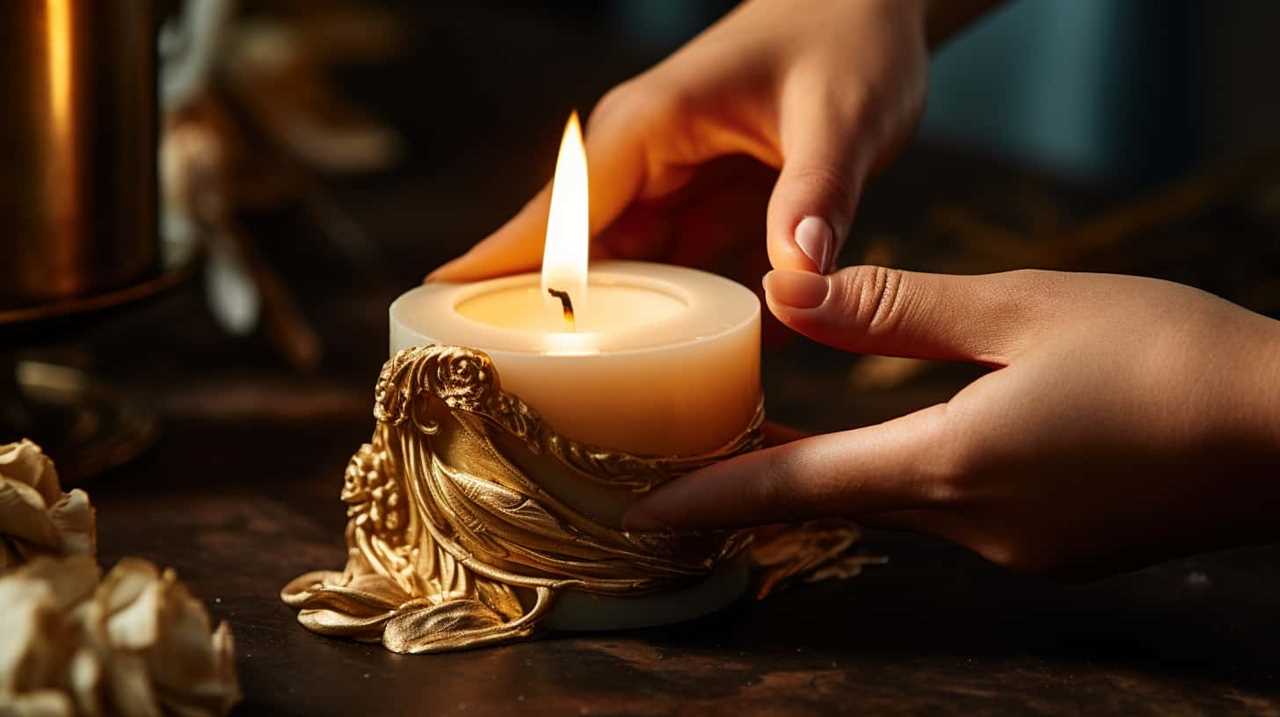
Additionally, the angle at which the light is emitted plays a role in candle power. Narrower angles tend to result in higher candle power, while wider angles lead to lower values.
These factors, among others, are essential to consider when using measurement techniques to determine candle power accurately.
Candle Power Vs Lumens: Understanding the Difference
As we delve into the comparison between candle power and lumens, it becomes clear that understanding the difference is essential. When it comes to measuring the brightness of a light source, lumens are the preferred unit of measurement. Here are three key differences between candle power and lumens:
- Lumen Measurement: Lumens measure the total amount of visible light emitted by a light source. It takes into account the entire range of visible light, making it a more accurate indicator of brightness.
- Candle Power Formula: Candle power, on the other hand, measures the intensity of light in a specific direction. It’s calculated by dividing the total luminous flux by the solid angle in steradians.
- Practical Application: Lumens provide a more practical measurement for everyday use. They help us understand how bright a light source will appear to the human eye, while candle power is more suitable for specialized applications like spotlighting.
Understanding the difference between candle power and lumens allows us to make informed decisions when choosing lighting options for our specific needs.
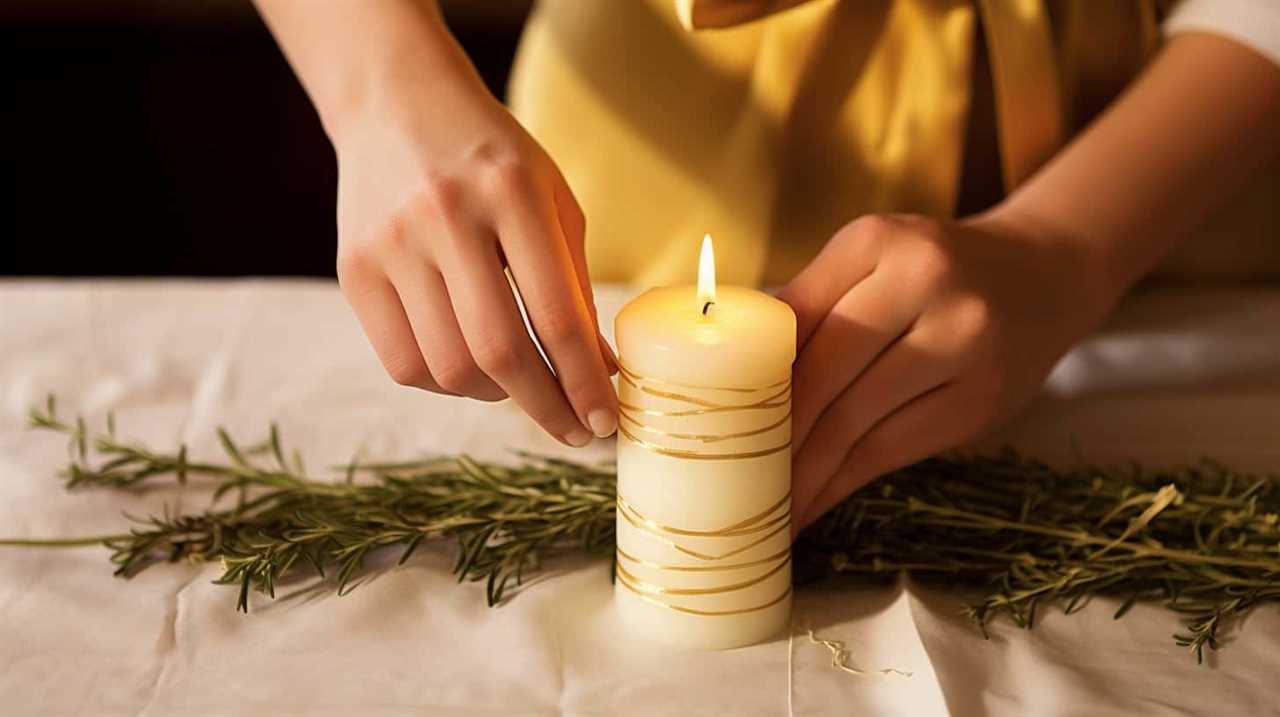
Factors Affecting Candle Power
Although there are several factors that can affect candle power, one important factor to consider is the type of light source being used. Different light sources produce varying levels of candle power due to their unique characteristics.
For example, incandescent bulbs typically have a higher candle power compared to fluorescent or LED bulbs. The quality and condition of the light source can also impact its candle power. Factors such as age, cleanliness, and maintenance can affect the performance of the light source and subsequently its candle power.
Measurement techniques play a crucial role in determining candle power accurately. Using a light meter, the intensity of the light emitted by the source can be measured, providing a quantitative value for candle power.
Practical Applications of Candle Power
Considering the factors that affect candle power, measuring the intensity of light emitted by a source using a light meter provides a quantitative value for assessing its candle power. Understanding the practical applications of candle power can help us serve others better, especially in fields like photography and automotive lighting. Here are three key applications:
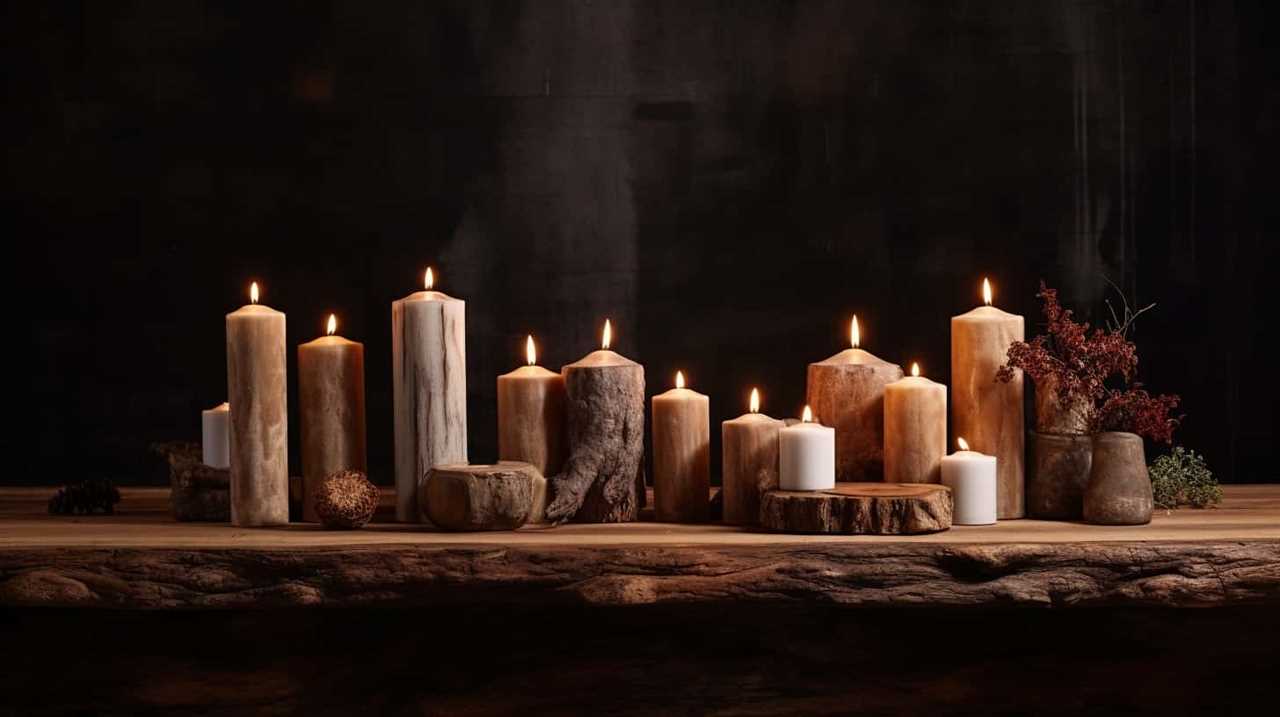
- Candle power in photography: Knowing the candle power of different light sources allows photographers to control the lighting conditions and achieve the desired effects in their photos. Whether it’s studio lighting or outdoor shoots, candle power helps determine the ideal lighting setup for capturing stunning images.
- Candle power in automotive lighting: The candle power of headlights and other automotive lighting systems directly affects visibility on the road. By ensuring a high candle power, drivers can enhance safety by providing optimal illumination and reducing the risk of accidents, especially in low-light or adverse weather conditions.
- Overall illumination assessment: Candle power measurements play a crucial role in assessing the overall lighting conditions in various settings. From evaluating the effectiveness of lighting in commercial spaces to ensuring proper illumination in public areas, candle power measurements aid in creating comfortable and safe environments for everyone.
Understanding the practical applications of candle power allows us to make informed decisions and optimize lighting for different purposes, ultimately serving others by enhancing their experiences in photography and ensuring safety on the roads.
Frequently Asked Questions
How Does Candle Power Affect the Visibility of a Light Source?
The effect of candle power on brightness and the impact of candle power on visibility are closely related. Higher candle power results in greater brightness, which in turn improves the visibility of a light source.
Can Candle Power Be Used to Measure the Efficiency of Different Light Sources?
Candle power can be used to measure the efficiency of different light sources. By comparing the candle power, we can determine the impact on energy consumption, helping us make informed choices.
Are There Any Safety Concerns Related to High Candle Power Light Sources?
Safety concerns may arise with high candle power light sources due to the risks associated with intense heat and potential fire hazards. It is essential to handle such sources with caution and ensure proper ventilation to prevent accidents.

How Does Candle Power Compare to Other Units of Measurement for Light Intensity, Such as Lux or Foot-Candles?
When comparing light intensity, candle power is like a bright star guiding our way. It offers advantages in lighting design, allowing us to measure and understand the power of light in a concise and informative manner.
Can Candle Power Be Used to Determine the Lifespan of a Light Bulb or Lamp?
Candle power is a unit of measurement for light intensity. It can’t be used to determine the lifespan of a light bulb or lamp. Factors affecting candle power include distance, reflectance, and the wattage of the light source.
Conclusion
In conclusion, understanding candle power is essential for determining the brightness of a light source. By measuring the intensity of light emitted from a single candle, candle power provides a standardized unit of measurement.
While it may seem outdated compared to the more commonly used lumens, candle power still holds value in certain applications.

So, next time you’re in a dark room, remember that a little knowledge about candle power can shed light on the situation.
I’m Jane and I love candles. I have candles everywhere in my house–in every room, on every surface. I love the smell of candles, and I love how they make my place feel warm and cozy.
Candles are really important to me. They help me relax and de-stress after a long day. They remind me of happy memories, and they make me feel calm and peaceful. I can’t imagine my life without candles!
-
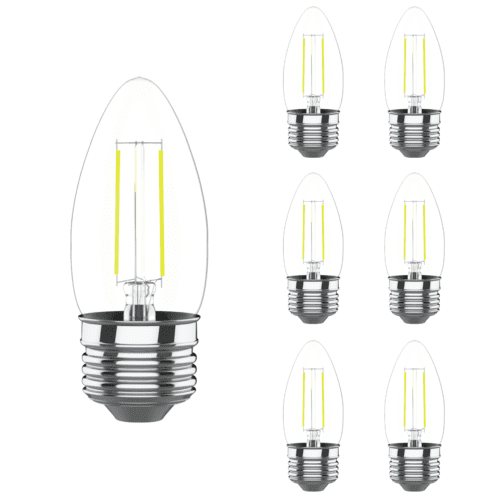
 Beginners Guides1 week ago
Beginners Guides1 week agoThe Similarities of Candle and Light Bulb Lamps
-

 Beginners Guides7 days ago
Beginners Guides7 days agoHow to Determine If Candles Will Melt Outside
-

 Beginners Guides3 months ago
Beginners Guides3 months agoHow To Burn A Candle Without A Wick
-
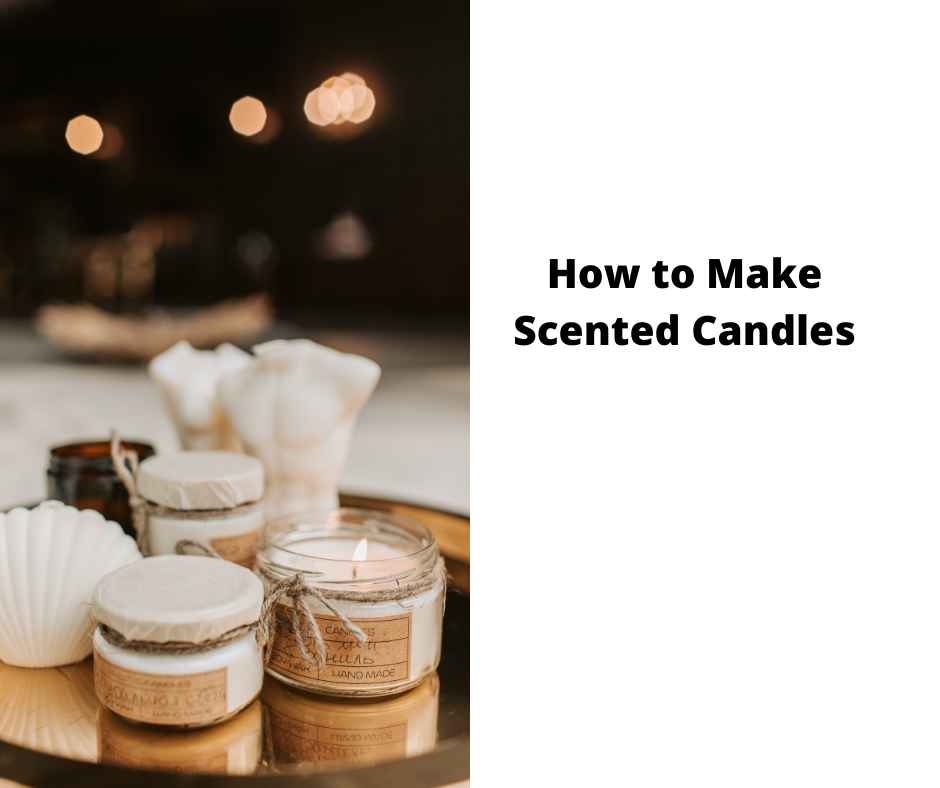
 Candles3 weeks ago
Candles3 weeks agoHow to Make Scented Candles
-
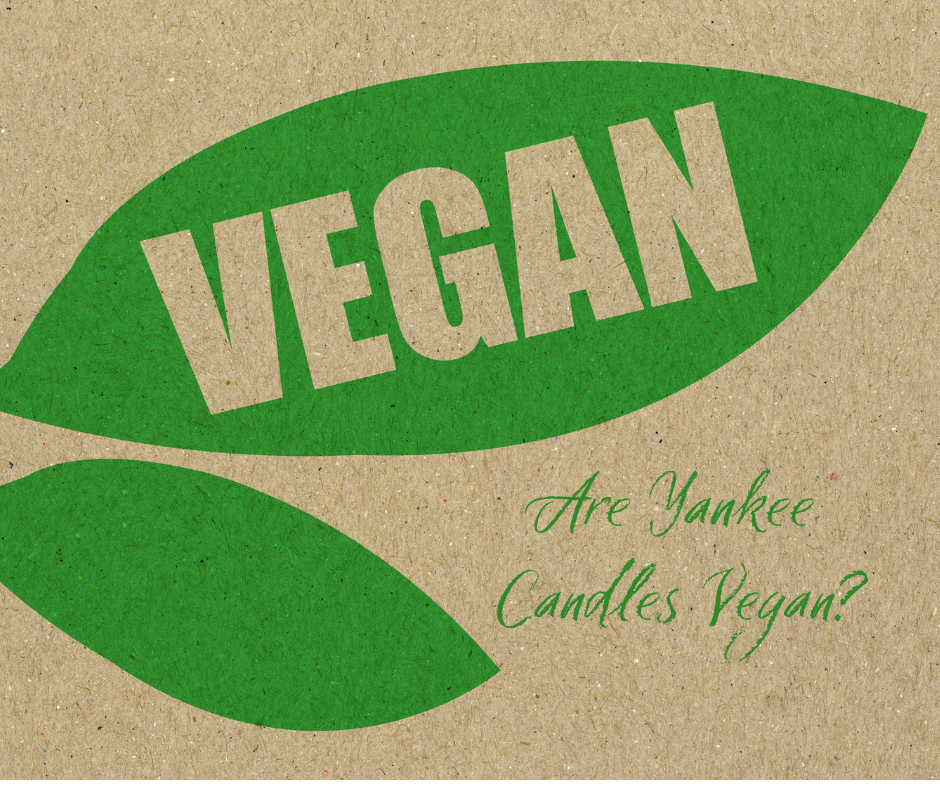
 Beginners Guides3 weeks ago
Beginners Guides3 weeks agoAre Yankee Candles Vegan?
-
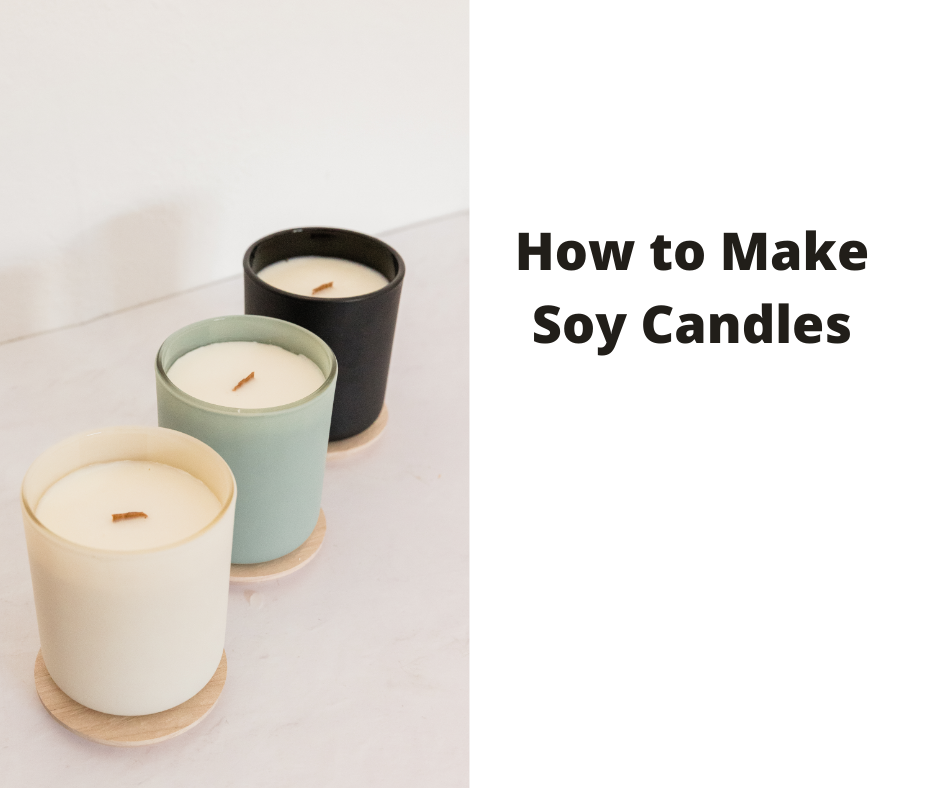
 Beginners Guides3 weeks ago
Beginners Guides3 weeks agoHow to Make Soy Candles
-

 Beginners Guides1 month ago
Beginners Guides1 month agoHow to Make Candles in 5 Easy Steps
-

 Beginners Guides1 week ago
Beginners Guides1 week agoWhy is My Candle Not Sticking to the Glass?







